One of the most mystical places we have ever been to, and our second favourite place in China after The Great Wall near Beijing, Zhangjiajie National Park and the Wulingyuan Scenic Area has to be right at the top of your must-visit places on a trip to China. Even though the place rose to fame as the inspiration for James Cameron in his blockbuster hit Avatar, this China landmark is still not on many tourists and travellers’ radar. Although over the next few years, we expect that to change, so make sure you visit it as soon as possible. You won’t regret it. To help you along – especially since most of the information out there is pretty confusing – we’ve put together this epic 3 days in Zhangjiajie guide for this UNESCO World Heritage site; our ultimate Zhangjiajie itinerary.
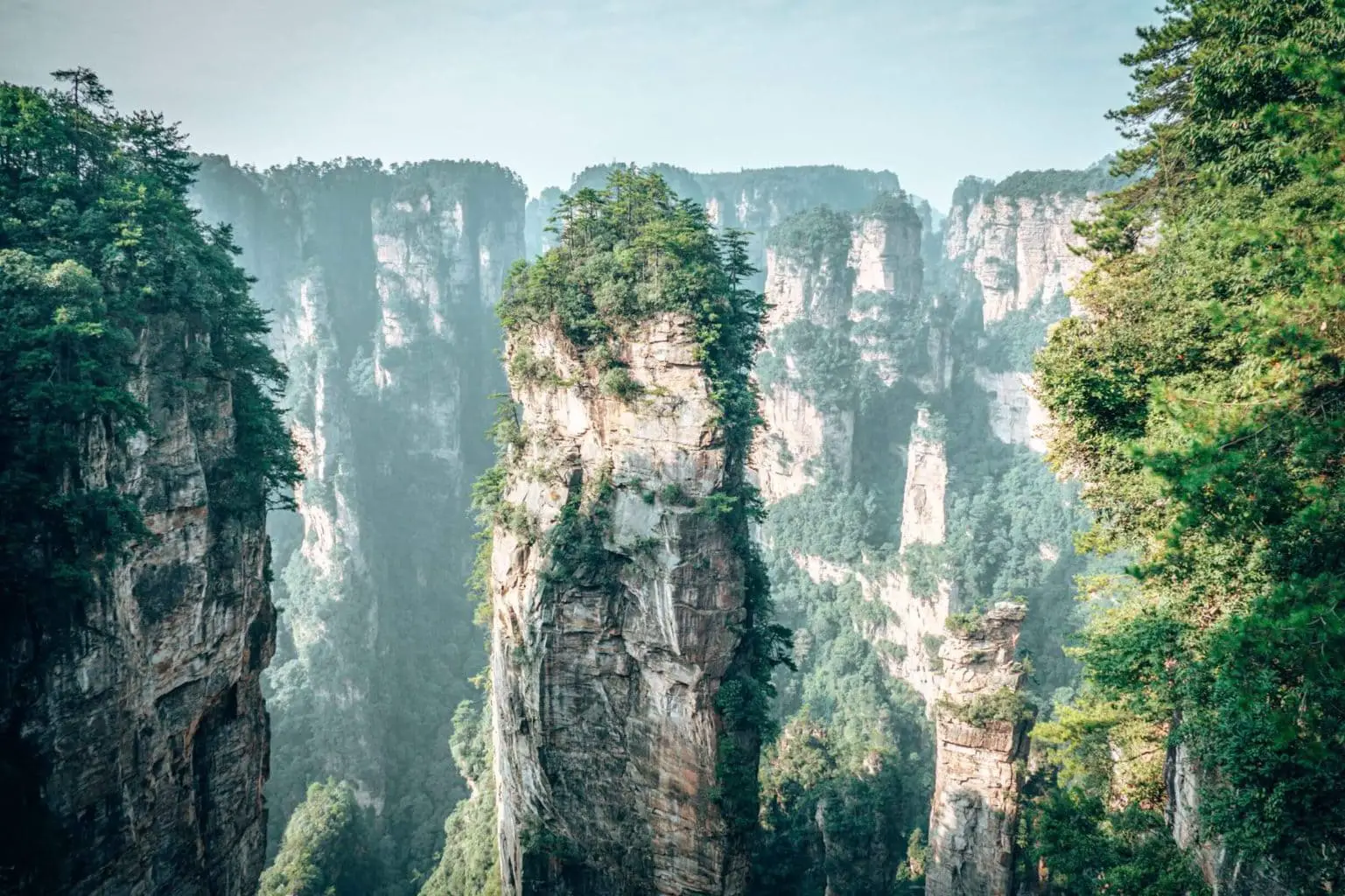
Skip ahead
What is the Zhangjiajie National Forest?
Ok, the first thing that’s pretty important to understand is that when people talk about Zhangjiajie, they are generally referring to the absolutely stunning national park, but what’s really important to know is that there are two cities – Zhangjiajie and Wulingyuan, that are located either side of the Wulinguan Scenic Area, in which sits the Zhangjiajie National Park (one of 4 main areas). The cities are about 45 minutes to an hour (traffic dependant) apart, and based on your Zhangjiajie itinerary, it’s key to choose the right location to base yourselves. We’ll delve a little deeper into that when we talk about accommodation…!
So what exactly is the Zhangjiajie National Forest?
This is actually the first area that was discovered in the Wulingyuan Scenic Area, with Tianzi Mountain, Yuanjiajie (the most famous section with the Avatar Hallelujah Mountains) and Yangjiajie making up the other 3 areas of the park. However, with it being the first discovered area, it’s the name that has really stuck and is far better known than the Wulingyuan Scenic Area.
The whole park however offers breath-taking scenery, gravity-defying sandstone pillars and some of the best hiking that we have ever had the luck to explore.
Located in the northwest of the Hunan Province, the scenic and historic interest area spans across 400 square kilometres.
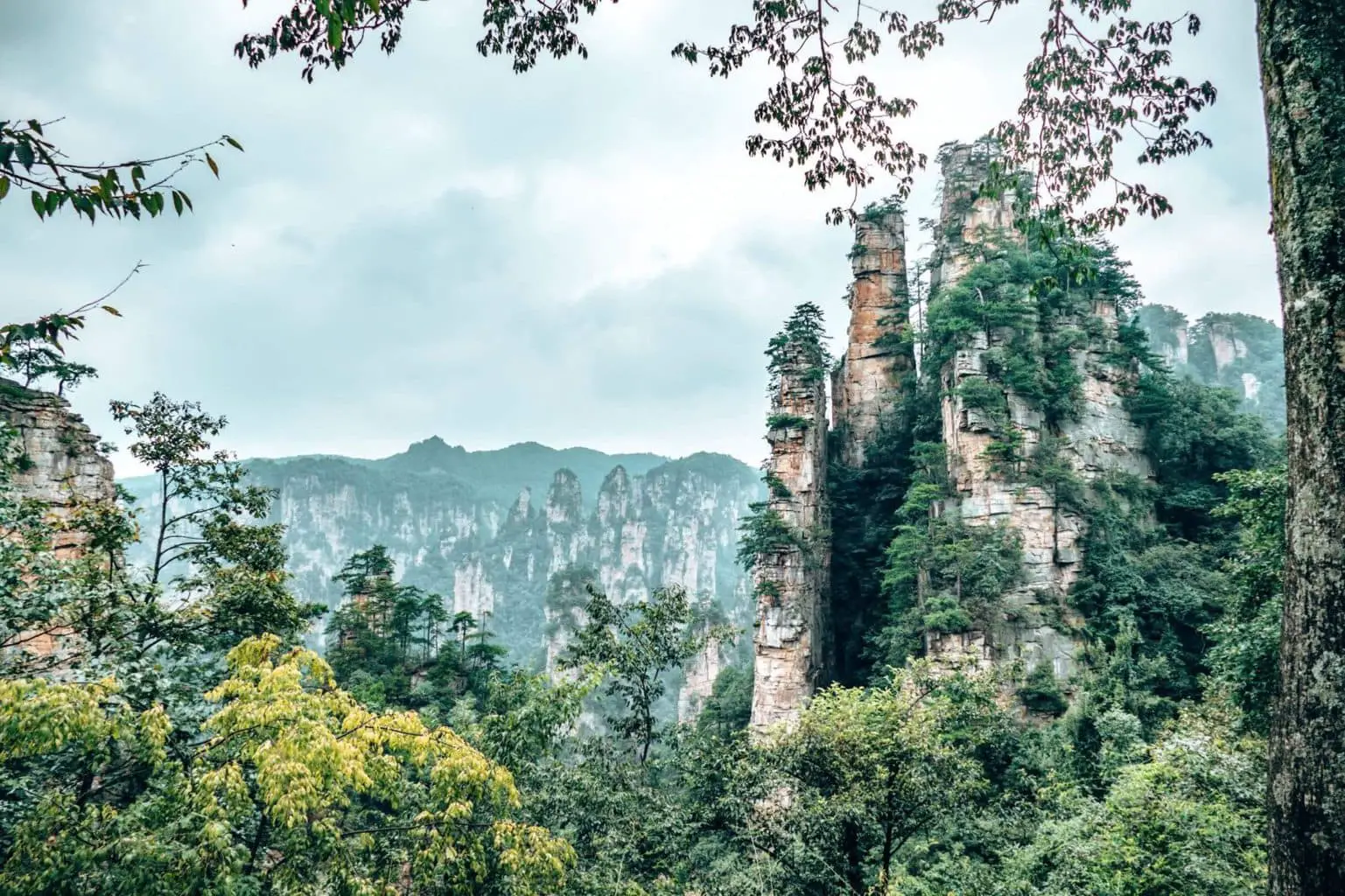
How long do I need in Zhangjiajie?
Although it depends on your general hiking ability and fitness levels, we believe that you need to give yourself at least 3 days to explore all the key sights and viewpoints in Zhangjiajie and Tianmen. Although this article outlines what is a bit of a whistle-stop Zhangjiajie itinerary, with pretty intense (but very achievable) routes for those 3 days, you could easily extend your stay in the area and do our suggested itinerary over a 5 day period if you wanted to do it in a more relaxed way.
And if you are even faster travellers than us, and can only dedicate one day to this incredible area, we would recommend that you take our day 1 itinerary – you’ll see the most famous sights.
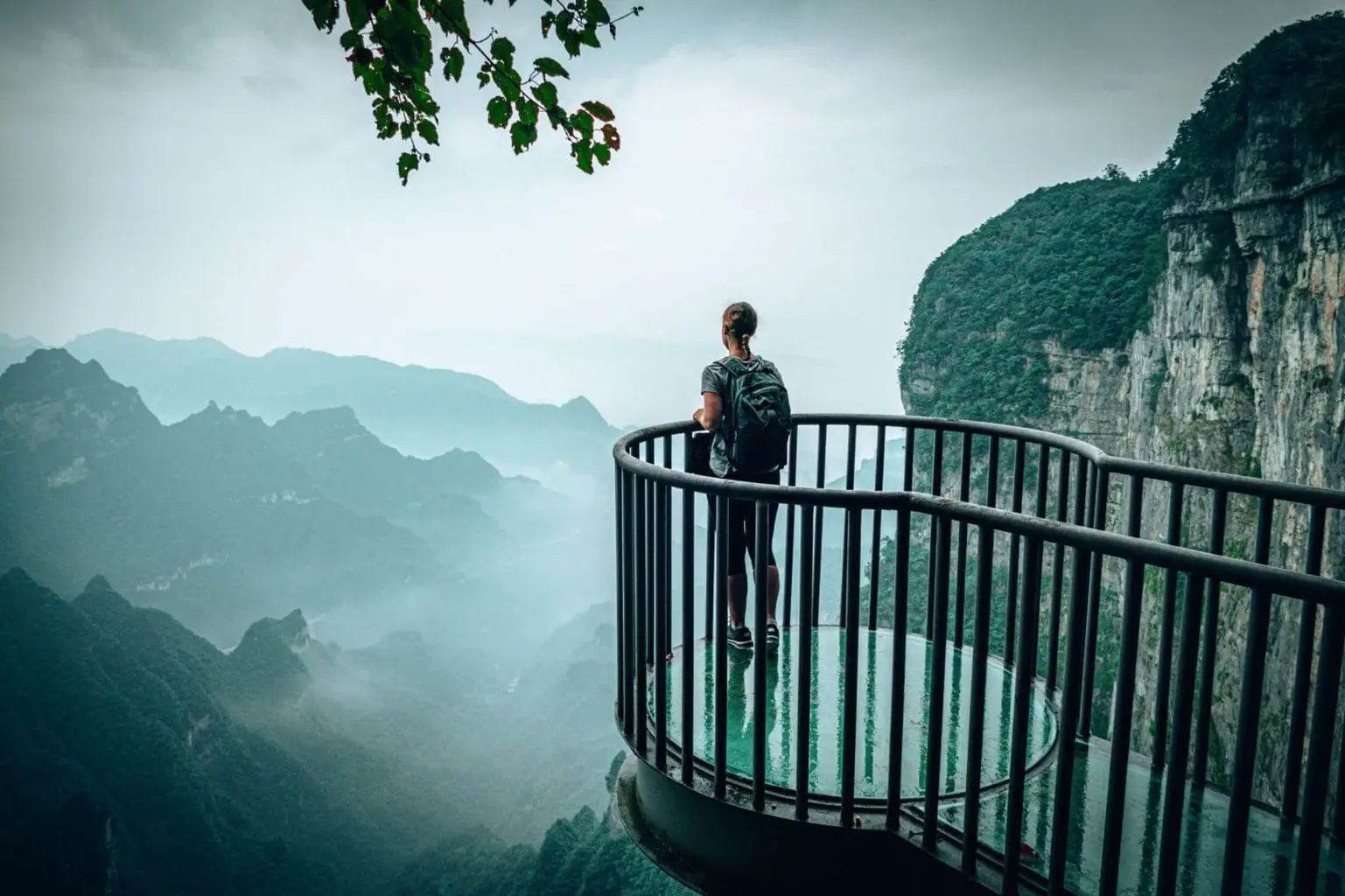
What is the perfect Zhangjiajie itinerary?
- Day 1 | The Bailong Elevator, Avatar Mountains, Yangjiajie and Tianzi Mountain
- Day 2 | Golden Whip Stream & Huangshi Village
- Day 3 | Tianmen Mountain
How to get to Zhangjiajie National Park and Wulingyuan Scenic Area
By train
So if you’re doing a much larger China itinerary, you’ll most likely be doing the more common loop from Beijing (check out our Beijing itinerary here), Xi’an (we also have a Xi’an city guide) and Chengdu – from here, we would recommend that you take a train to Changsha, stay the night in Changsha and then get the train to Zhangjiajie.
There are very much two different classes of train travel in China: the super modern, fast, clean efficient bullet trains that make major intercity journeys an absolute pleasure and in my opinion better than a flight. And then there are the more local intercity trains, which are waiting to be updated and if you’ve travelled in Asia, much more something you’ll be accustomed to facing. For the train from Changsha to Zhangjiajie you’re looking at the latter.
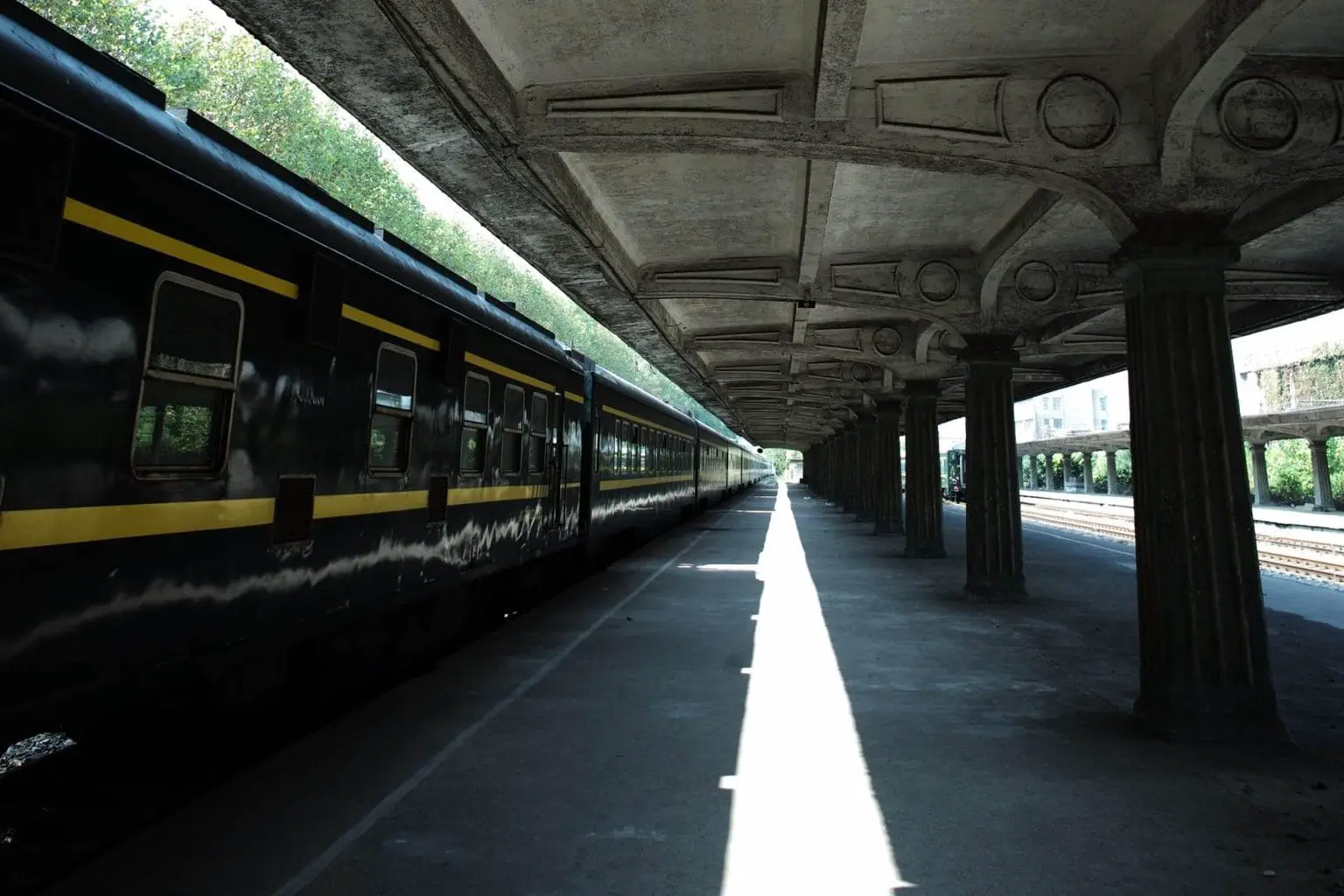
Booking trains in China is actually a relatively simple process. Unless you have a Chinese mobile, ID and understand Mandarin, you’ll need to use a third party supplier. We booked ours through China Highlights, which was a great service, they add a small mark up to the ticket prices, but it’s very easy to use. They also have a great app China Train Booking.
Helpful tip: You can pick up all your train tickets for travel at any mainline station in China. Just make sure you have the booking reference and your passport with you!
By bus
You can also take a bus directly from Fenghuang (the Ancient city of Phoenix), another popular stop on the tourist trail in China. The bus was very comfortable and took about 4 hours. We’d recommend that if you’re travelling in the busier summer holiday time (July and August) or around any major China holidays to book in advance. The best option seems to be China Bus Guide. However, although we did this journey in reverse (from Wulingyan bus station to Fenghuang) we were able to buy tickets at the bus station the day before we travelled.
If you’d like more advice on a full China itinerary, make sure you get in touch with us here, or leave a comment below and we’ll come back to you!
Flights
The obvious other alternative is to look into flights. Which, although more expensive than the train or bus options, is definitely faster and more convenient. Check out the latest prices on Skyscanner.
Travel Insurance for China
Got your travel insurance booked? We promise to never push a brand or product we don’t personally use, and the travel cover from Safety Wing is a policy we don’t just use, but we highly recommend. They offer some of the most flexible policies, amazing customer service and are affordable too.
Check out the latest travel insurance prices with Safety Wing here.
Where to stay in Zhangjiajie?
As we mentioned a little earlier in the article, it really is important to make sure that you base yourself in the right area. Zhangjiajie is actually a city (as most things are in China, surprisingly larger than we expected, with 1.5 million inhabitants). It is the location for the cable car to take you to Tianmenshan (Tianmen Mountain), which we suggest as part of day 3 of our Zhangjiajie itinerary, however, for days 1 & 2, you definitely will want to stay in Wulingyuan. Most of the accommodation options here are walkable to the main entrance of the Zhangjiajie National Park and it has much more of a feel of a small town, which is really nice.
As the drive from Zhangjiajie city to the park entrance is 45 minutes, we’d really recommend you stay in Wulingyuan, particularly if you are keen to get there early and beat the crowds to the best spots. The easiest way to get to Wulingyaun from Zhangjiajie is to take the bus from the main bus station, handily also located right next to the main train station.
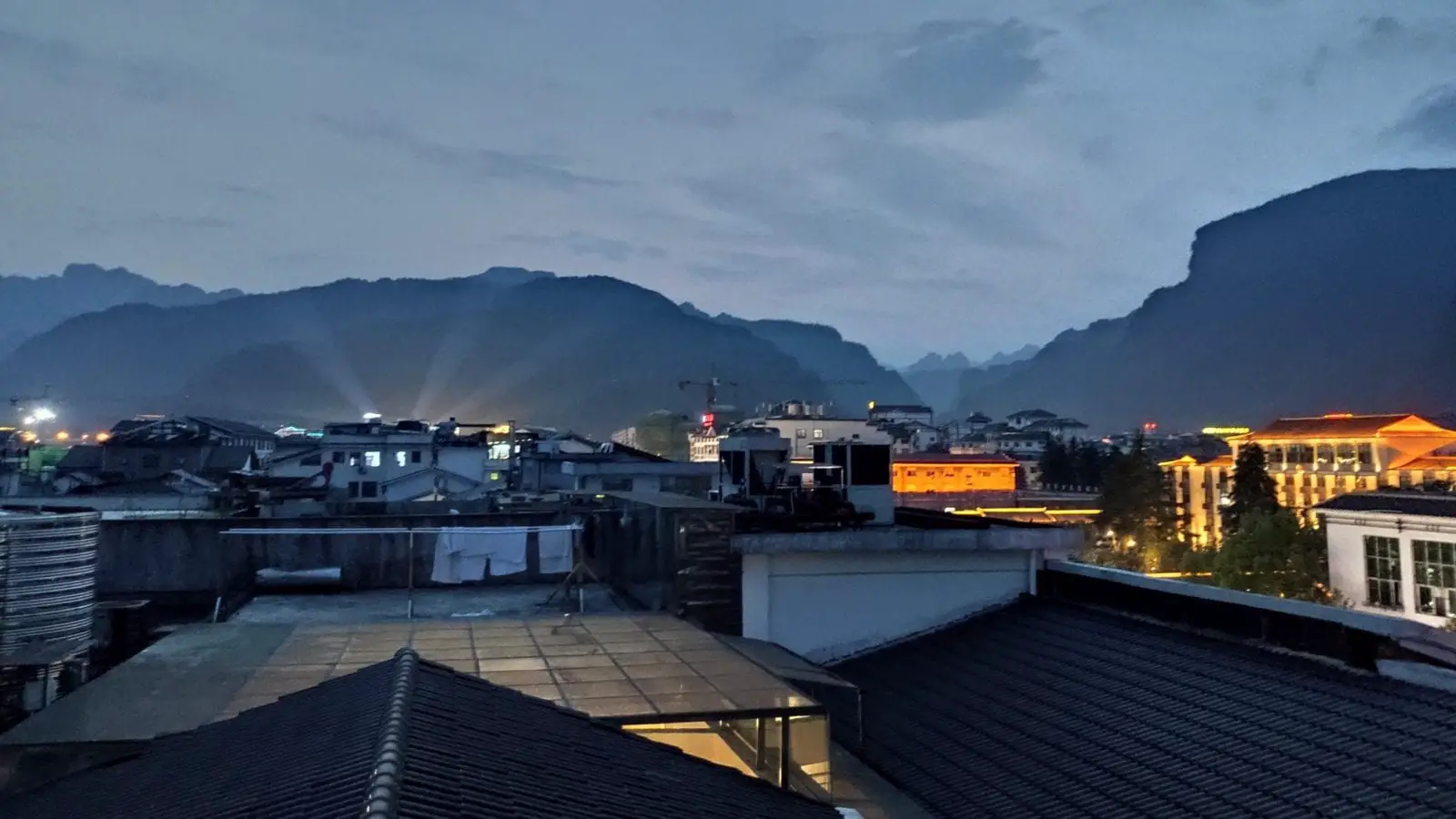
Budget: Backpackers will like the Wuling Yuantu Youth Hostel – it’s right next to the Wulingyuan ticket office so very handy! It has free wifi and really lovely rooms, so worth a look in!
Mid-range: We stayed at the Maosao Family Hotel and really liked it. It was a quick walk to the main entrance to the park, had lovely rooms with wooden features and soft white sheets – we particularly thought the family rooms had great value.
Luxury: There are quite a few good high-end hotels in Wulingyuan but we’d probably pick the Pullman, also since it has one of the best restaurants with Western food!
Buying your tickets for Zhangjiajie National Park, Wulingyan Scenic Area and Tianmen Mountain
For tickets to Zhangjiajie National Park and the Wulingyuan Scenic Area:
You can buy your tickets at any of the main gates into the park. The best bet is to get to the main gate in Wulingyuan as early as you can, the ticket office opens at 7.00 am. It’s always worth carrying your passport with you at all times in China – at most of the major tourist attractions you will need it, and here is no different. Your tickets (credit card style passes) are linked to your ID, and on your first time through the turnstiles they link your fingerprint to your pass!
If you’re a student, it’s worth taking the relevant ID with you as you’ll also be entitled to some pretty good discounts.
Tickets cost: 248 RMB (35 USD / 27 GBP) – this is a 4 day pass that covers your entry, access to all 4 areas of the park and buses within the park. Note that there are additional costs for the Bailong Elevator (72 RMB / 10.25 USD / 7.80 GBP) and Cable Cars (79 RMB / 11.25 USD / 8.60 GBP).
Insider Tip: Join the local tour guides, jump the fence and you’ll get your tickets before anyone else. We did it and it meant we were on the first buses!
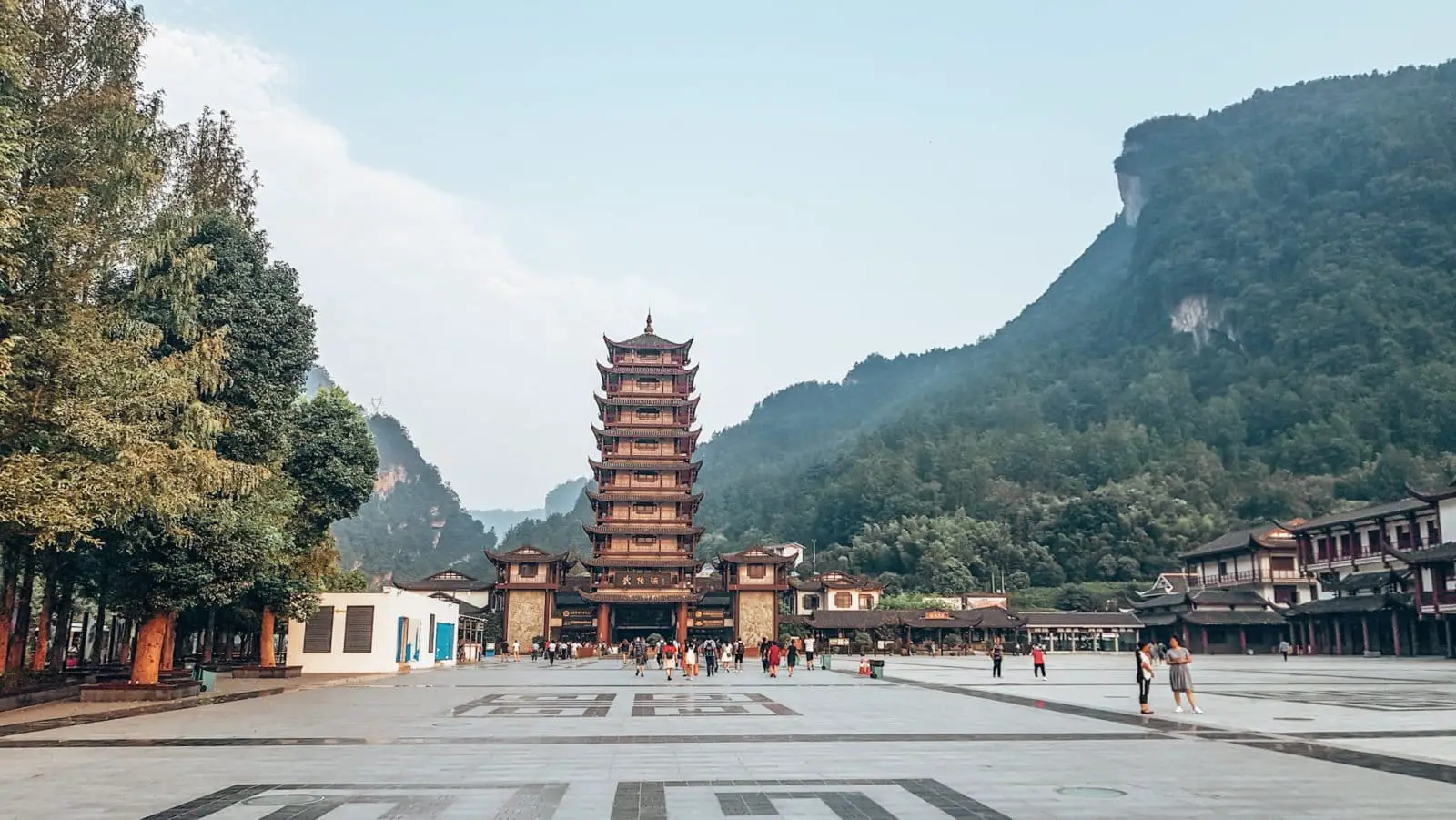
For tickets to Tianmen Mountain:
Chat to your accommodation and ask them to book your tickets in advance! They’ll need a photo of your passport which they send on to the ticket office to book your tickets, you will then collect the physical tickets. The ticket office is located at the base of the cable car, and there is a designated counter for pre-ordered tickets. There are morning or afternoon tickets available and you’ll definitely want to get yourself into one of the morning slots – the earlier you can get up Tianmen Mountain the better, as it can get quite busy by the afternoon.
There is a cable car that runs up to the top of Tianmen Mountain, and you’ll either be allotted a journey up on the cable car and down on the bus. Or vice versa. We would actually recommend asking for the bus up – it’s a relatively hairy drive up the mountain, with 99 hairpin turns in total, and although pretty exhilarating, it would be twice that on the descent.
Tickets for Tianmen Mountain cost: 261 RMB (37.25 USD / 28.40 GBP) and the ticket office opens from 7.00 am (note the park only opens from 8.00 am).
If you don’t feel so comfortable doing this itinerary without a tour guide, have a look at the various guided options with Get Your Guide.
Day 1 in Zhangjiajie
Ready to go and explore one of the most beautiful places in the world? Let’s kick off on the first day of your ultimate 3 day Zhangjiajie itinerary!
Bailong Elevator
So, get yourself up super early, get hold of your passes, and once in the main station, there are heaps of buses that ferry people around to all sections of the park. Point out that you want to go to the Bailong Elevator (also known as the Hundred Dragon Elevator) in the Yainjiajie section of the park and they’ll let you know which bus number to get on – it’s a relatively straight forward process, but with so many people and buses can appear quite confusing at first.
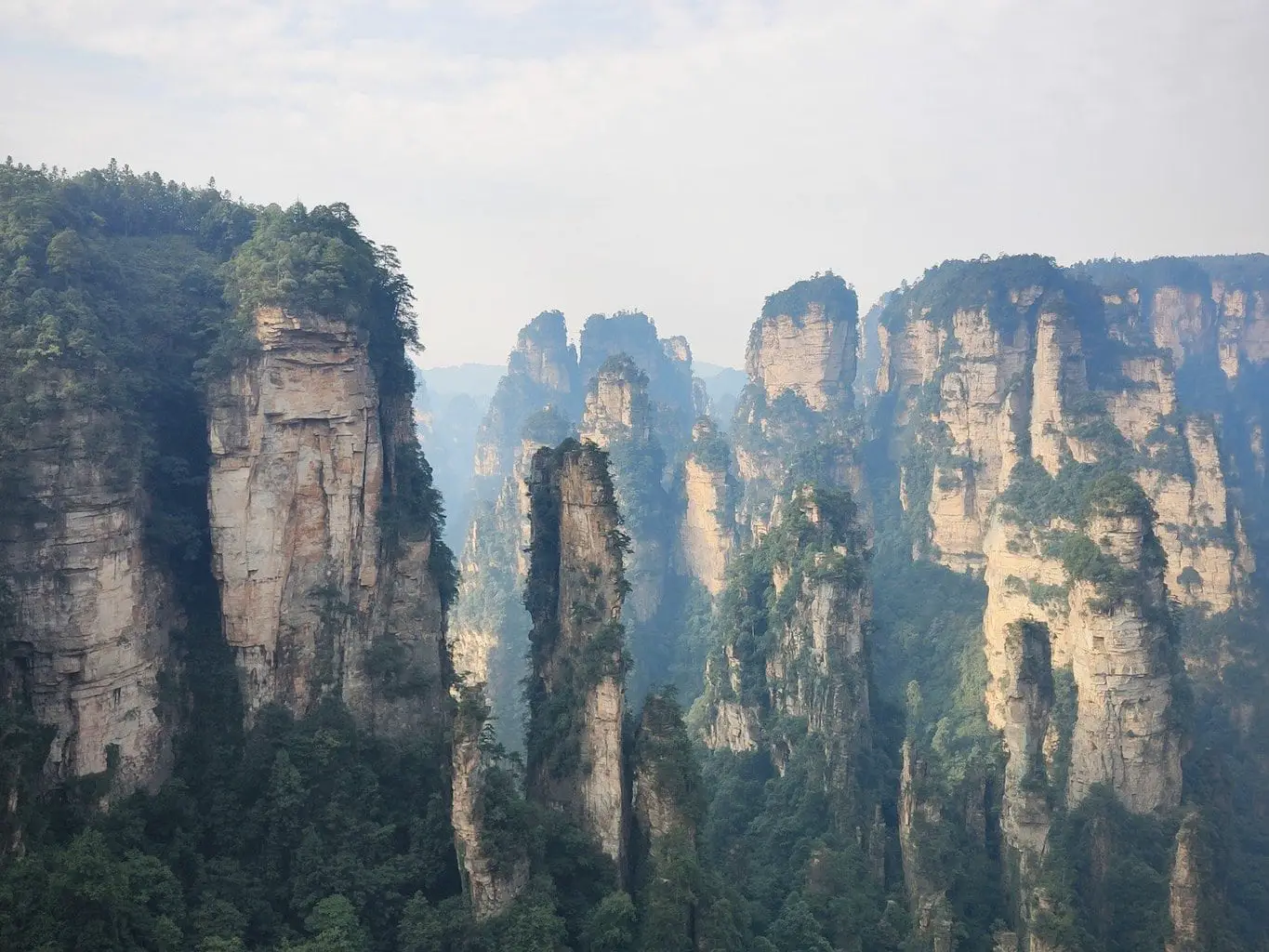
We managed to get onto the first bus of the day, and it was totally worth it! Once you arrive at the Bailong Elevator (the end of this bus line), you will need to purchase a ticket at the Bailong Elevator counters. There is an additional cost for the riding the elevator, but in our opinion it is totally worth it. The ticket price for this is: 72 RMB / 10.25 USD / 7.85 GBP.
Try and squeeze into the front of the elevator against the glass walls, face outwards and prepare yourself for the best lift ride of your life.
Tip: If you don’t get to the Bailong Elevator early, you can expect to queue for some time – we heard reports of people waiting a couple of hours to take the lift! So it’s really worth making the extra effort to be one of the first…
Avatar Mountains & Yuanjiajie
At the top of the Bailong Elevator, there is only one path that leads away, so you really can’t go wrong. Follow this path for about 400m where you’ll come to another bus station, where buses are waiting to take you along to the viewing platforms of the Southern Sky Column, the inspiration for the Avatar Mountains.
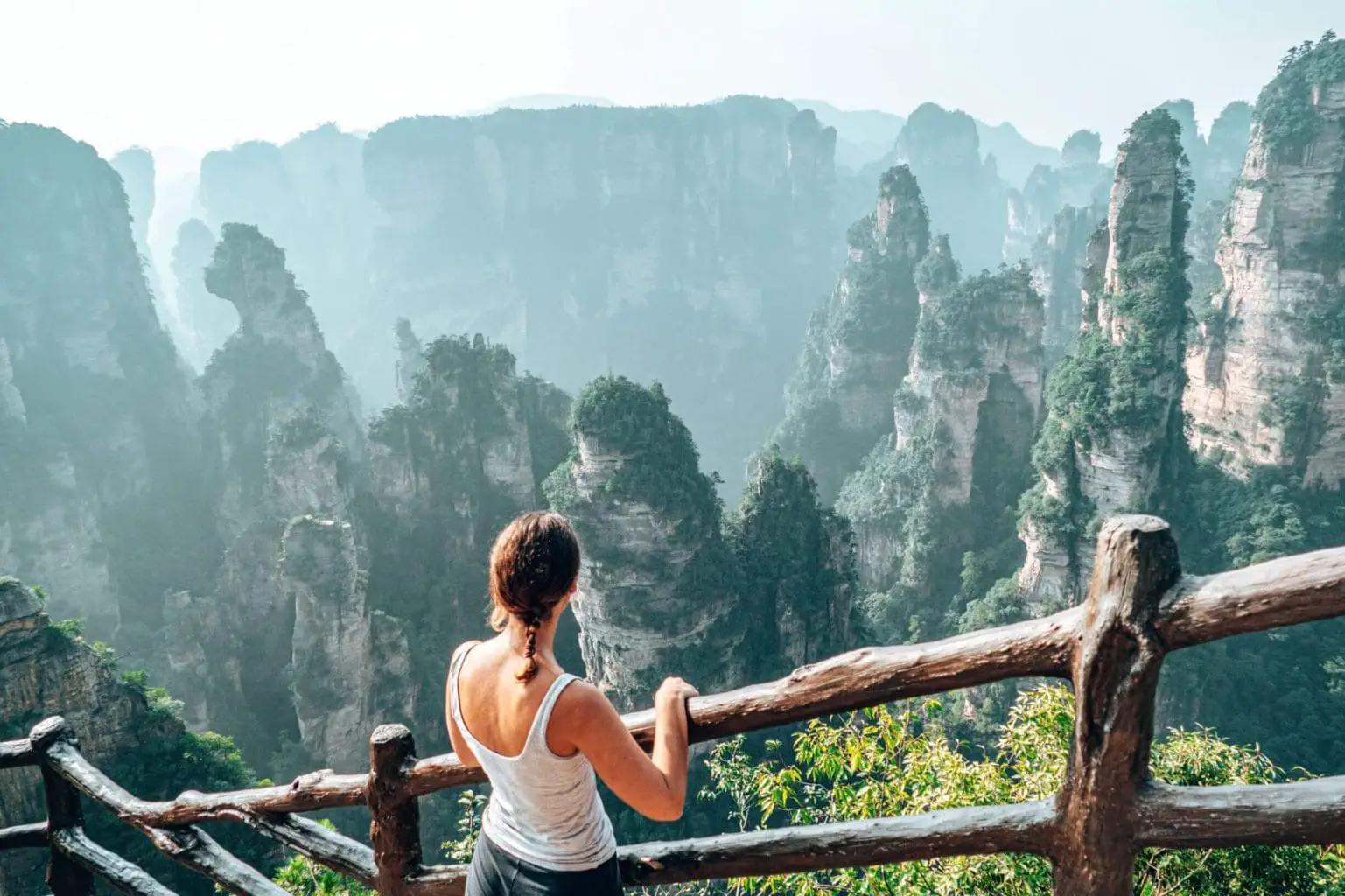
Along this walkway you’ll also encounter the First Bridge Under Heaven and the Lost Souls Platform. Each spot is amazing, and if you’re some of the first there in the morning, you get to experience this all without the crowds.
The walk should take you around 60 – 90 minutes depending on your speed and how much time you take to explore.
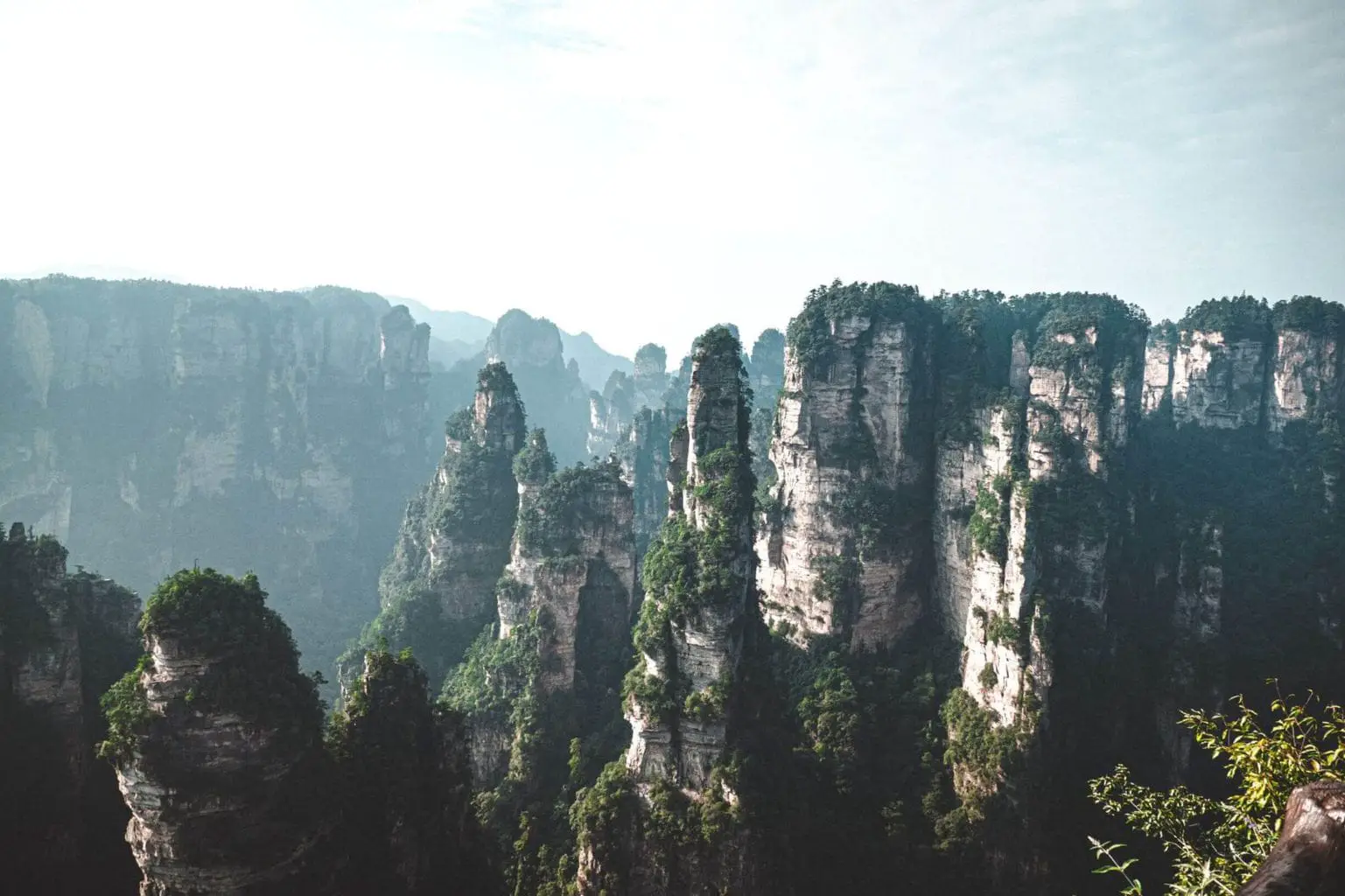
Yangjiajie
The next stop for the day is into the most recently discovered section of the park, Yangjiajie. There is a bus that will take you from the end of your walk in Yuanjiajie to Yangjiejie.
At the bus station, head out towards the Tianbo Mansion viewpoint. It’s about a 90 minute or so round trip, and you need to return here to move on to the next stop of the day. The walk to the viewpoint is really unique in that you’ll pass through the ancient Wulong Village, where you can still see the local traditional way of life.
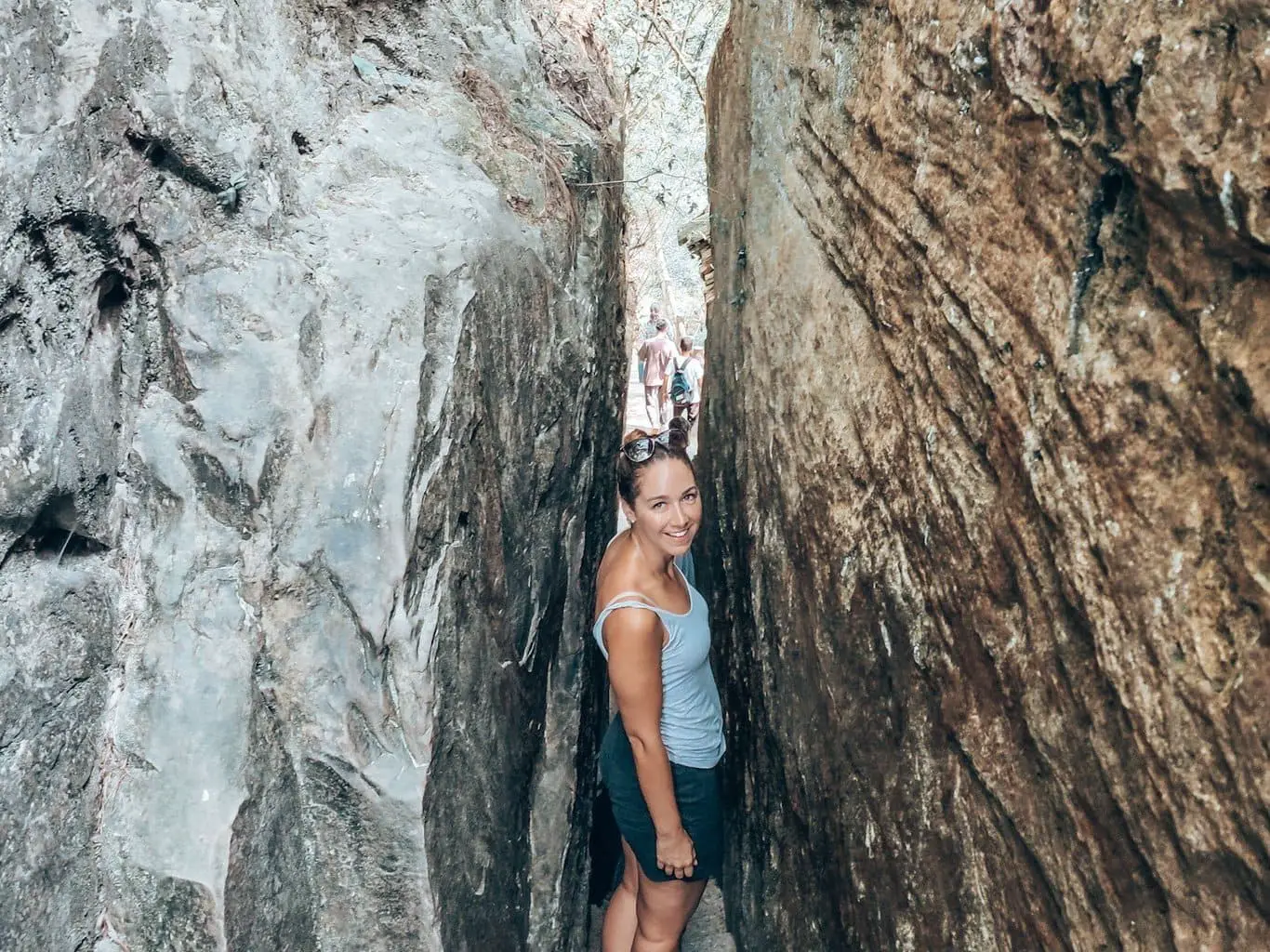
Heading on past the village, you then come to a very narrow naturally formed crevice, where the mountain has split, it’s a decent hike up plenty of steps, but there are a number of places to stop and have a rest on the way.
At the end of the path there is the opportunity to climb (on some relatively rickety looking metal stairs), up to the top of one of the sandstone pillars, which offers beautiful views of the Natural Great Wall.
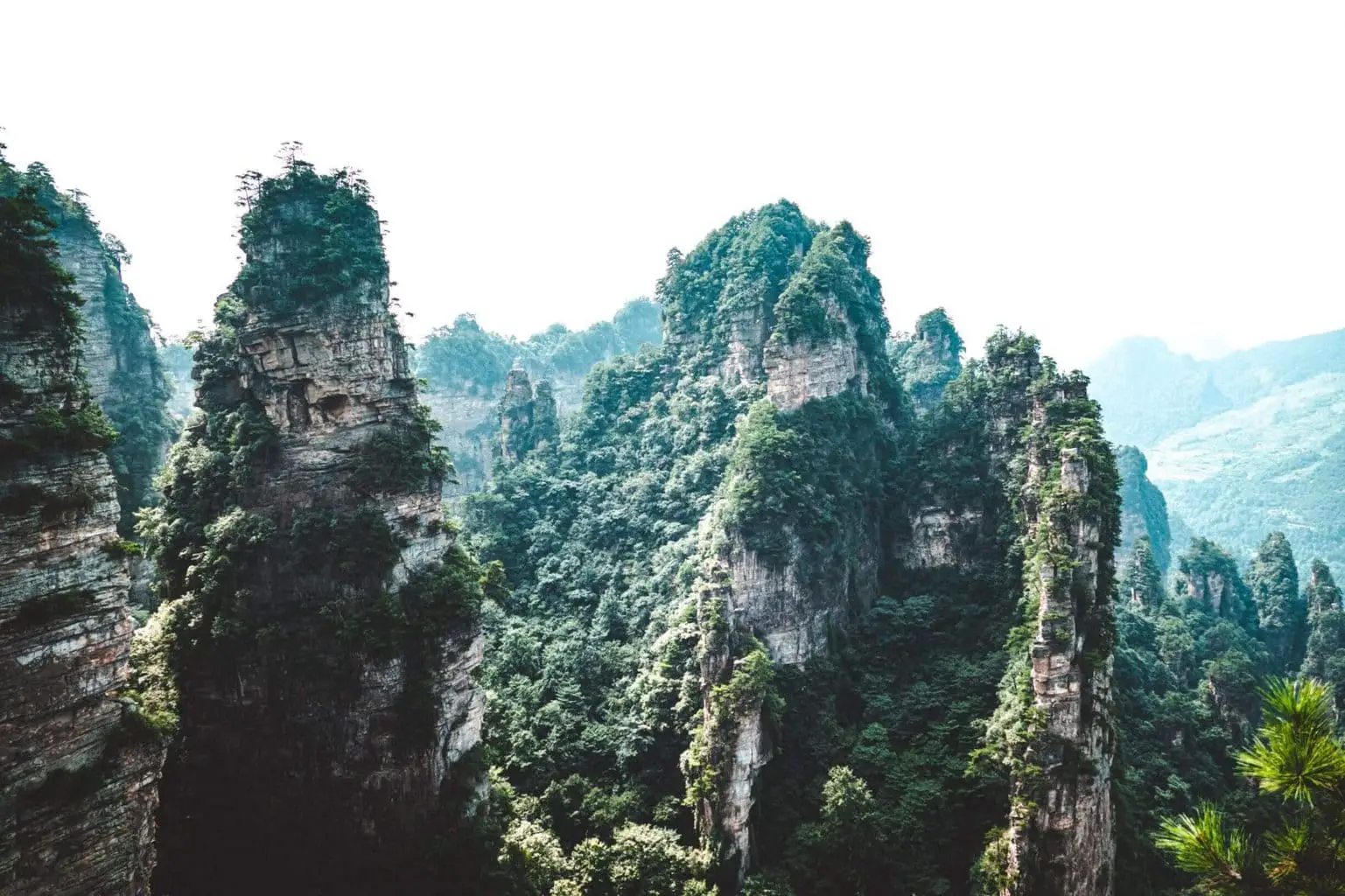
Tianzi Mountains
After returning to the Yangjiajie bus station, get on a bus for the journey to the Tianzi Mountains, this is the last section to explore for today. This for us provided two of the most ‘wow’ moments of the day. Firstly, and the bad wow, there’s actually a McDonalds at the summit of Tianzi Mountain!
But then for the amazing wow: Head past the McD’s and look for the Warrior Taming Horse lookout. This has to be, for us anyway, the best viewpoint on the mountain.
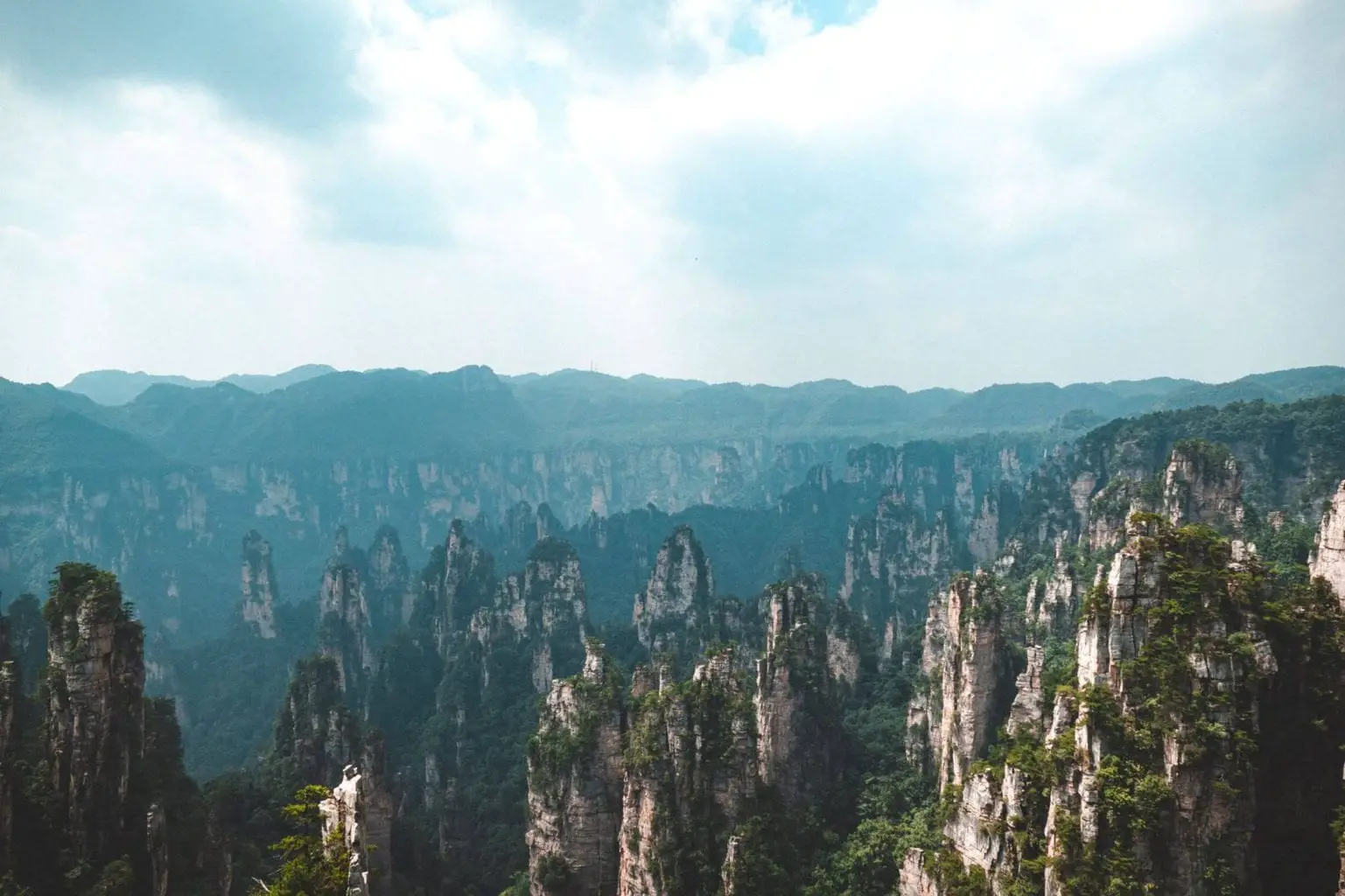
Keep exploring the tracks at the top, as there are stunning viewpoints everywhere, and once you’ve had your fill of idyllic scenery, we’d suggest that you walk all the way down. You can of course take the cable car back down, which is probably slightly easier on the knees. But, much to our surprise, the walk down was virtually deserted and we passed hardly anyone, except some poor souls who thought it would be a good idea to walk up Tianzi Mountain. No matter your fitness level, don’t attempt that!
There are a few café’s to stop at and get refreshments along the way, but the walk down really does provide different levels and perspectives of the sandstone pillars to appreciate. And you get to pass through the stunning Southern Heavenly Gate. You can’t go wrong if you keep following the signs towards the Ten Mile Natural Gallery.
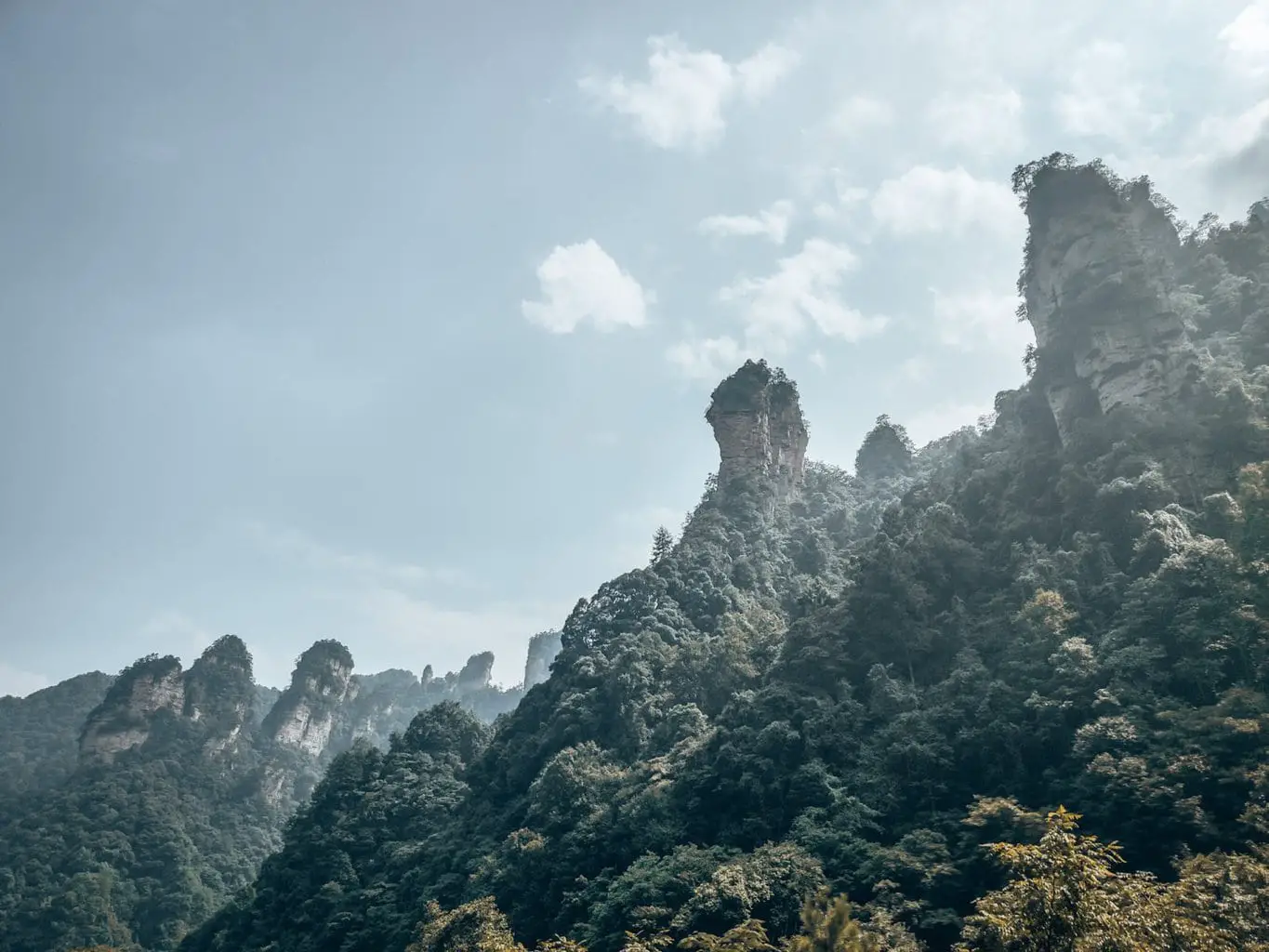
Once at the base, you’ll see a tram that you can take along this approx. 2 mile journey (not actually 10 miles as the name suggests), or just walk down. Here there are buses that can take you back to the Wulingyuan park entrance.
Note: If you wanted to extend your itinerary, you could quite easily separate Tianzi Mountain into its own hike!
Day 2 in Zhangjiajie
The Golden Whip Stream
So today it’s not quite as important to be first to the Park entrance, as you don’t need to rush to beat the queues at the Bailong Elevator. However, follow exactly the same initial journey as the first day and get the bus towards the lift – you’ll be wanting to get off the bus at the stop beforehand, called the Golden Whip Stream. Make sure you mention this to your driver (or point it out on the map) and they’ll stop for you at the right spot. And it is still definitely trying to get to the start as early as you can!
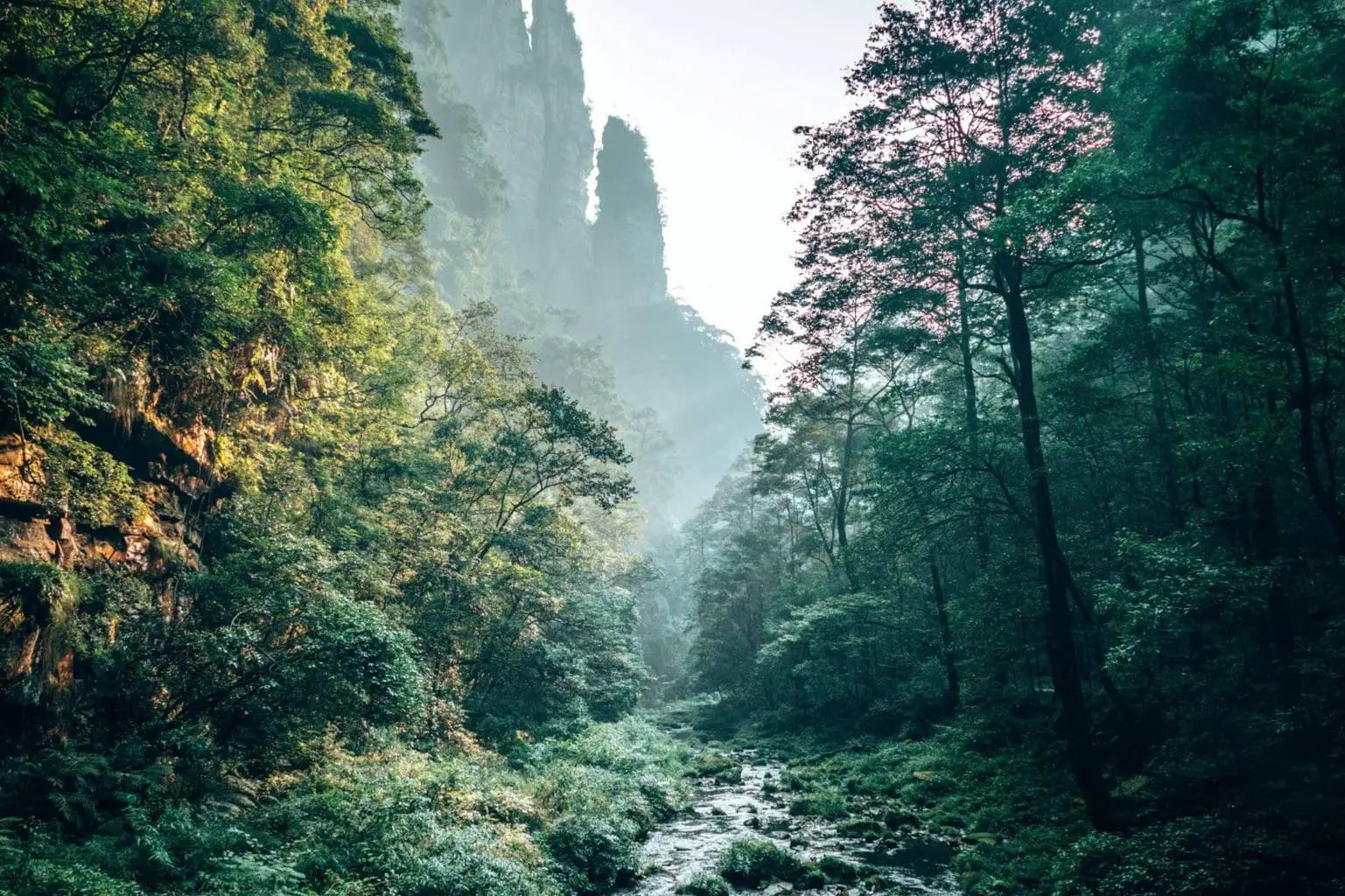
The first part of today’s hiking is really gentle, as the Golden Whip stream takes you along the river that flows in the valley. The most rewarding part of this is that you get the complete alternative to yesterday’s views, looking up to the looming sandstone pillars.
The Golden Whip Stream should take an hour or so to complete. You’ll also likely to bump into a few monkeys, but worth noting that it’s good to steer clear of them, we saw them on someone’s back opening their bag, looking for food.
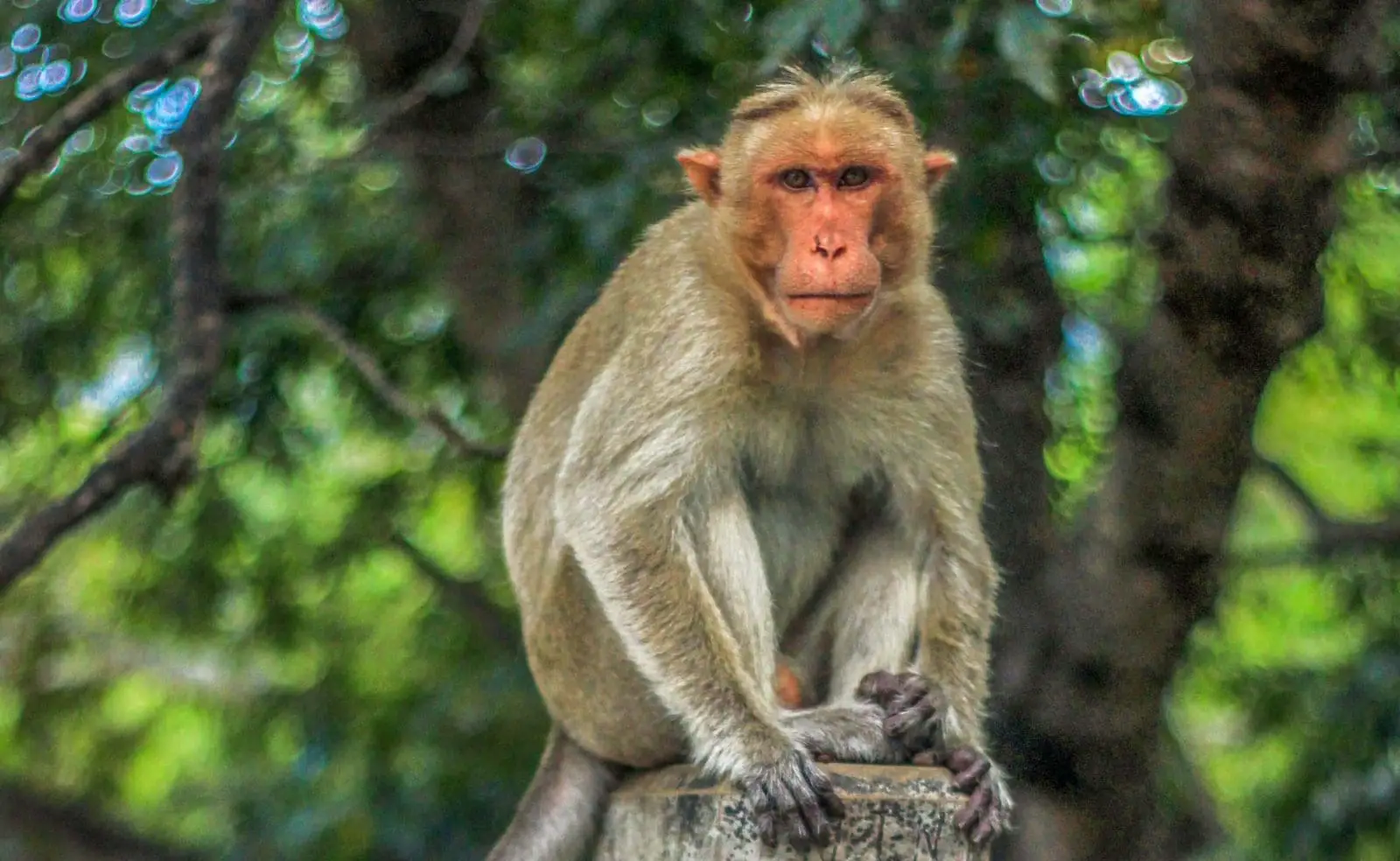
Huangshi Village
When you reach the end of the Golden Whip Stream – the interestingly named Oxygen Square – we’d suggest that you hike up to Huangshi Village. This is definitely the toughest section of our suggested itinerary as it is a pretty long climb up. And in general nothing but stairs… about 5,000 of them and a good 90 minutes of continuous stair climbing.
If you’re not keen on the hike up, you can also take a bus from Oxygen Square to the Huangshi Village cable car. You’ll pay extra for this ticket.
At the summit, we’d recommend that you take a walk around the entire mountain top, it’s meant to take around 3 hours in total, but in reality you can definitely do it a bit quicker. And it’s definitely worth the extra effort to walk all the way around – at the far side you see the Avatar Hallelujah Mountains from the reverse side.
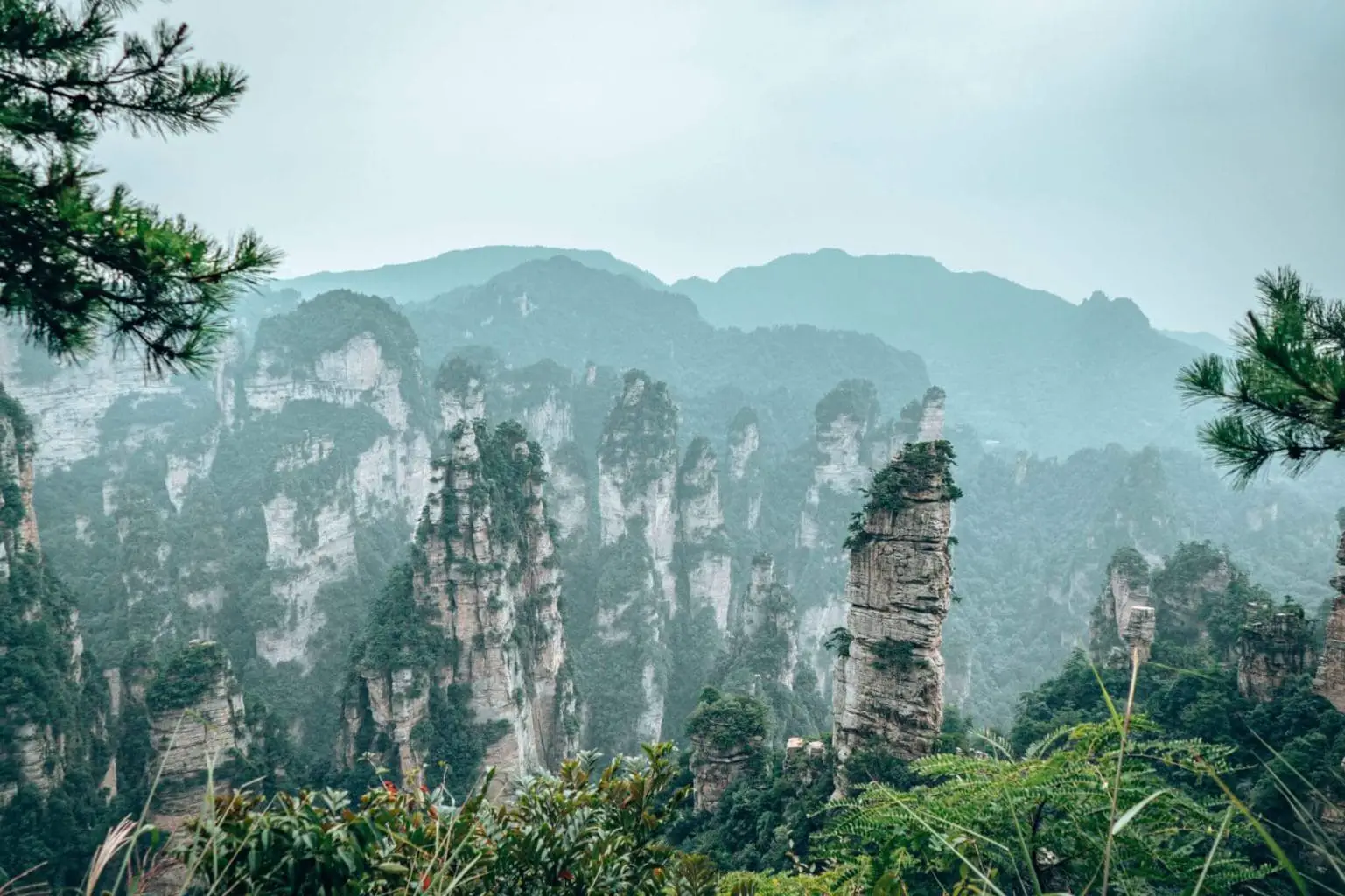
After finishing the loop, head back down the stairs to Oxygen Square. It’s much quicker on the way down and only takes about an hour.
Once you’re back down, you can either head back along the Golden Whip Stream (if you have the energy) to catch the free bus back to the Wulingyuan entrance. Or alternatively you can exit the park here at the Forest Park Station exit, where you will find buses heading back to Wulingyuan bus station.
Note: you have to pay for this bus back to Wulingyuan but it’s not expensive at 20 RMB (2.85 USD / 2.20 GBP).
Day 3 in Zhangjiajie
Tianmen Mountain
If you are staying in Wulingyuan, make sure that you allow yourself enough time to get to the Cable Car Station in Zhangjiajie city, the buses depart for Zhangjiajie from Wulingyuan bus station and depart every 20-30 minutes from around 7.00am. If you point out to the bus driver that you want to get off at the Cable Car, the bus drivers are usually super helpful and will let you know when to get off, but it’ll be quite obvious as you’ll see the cable car.
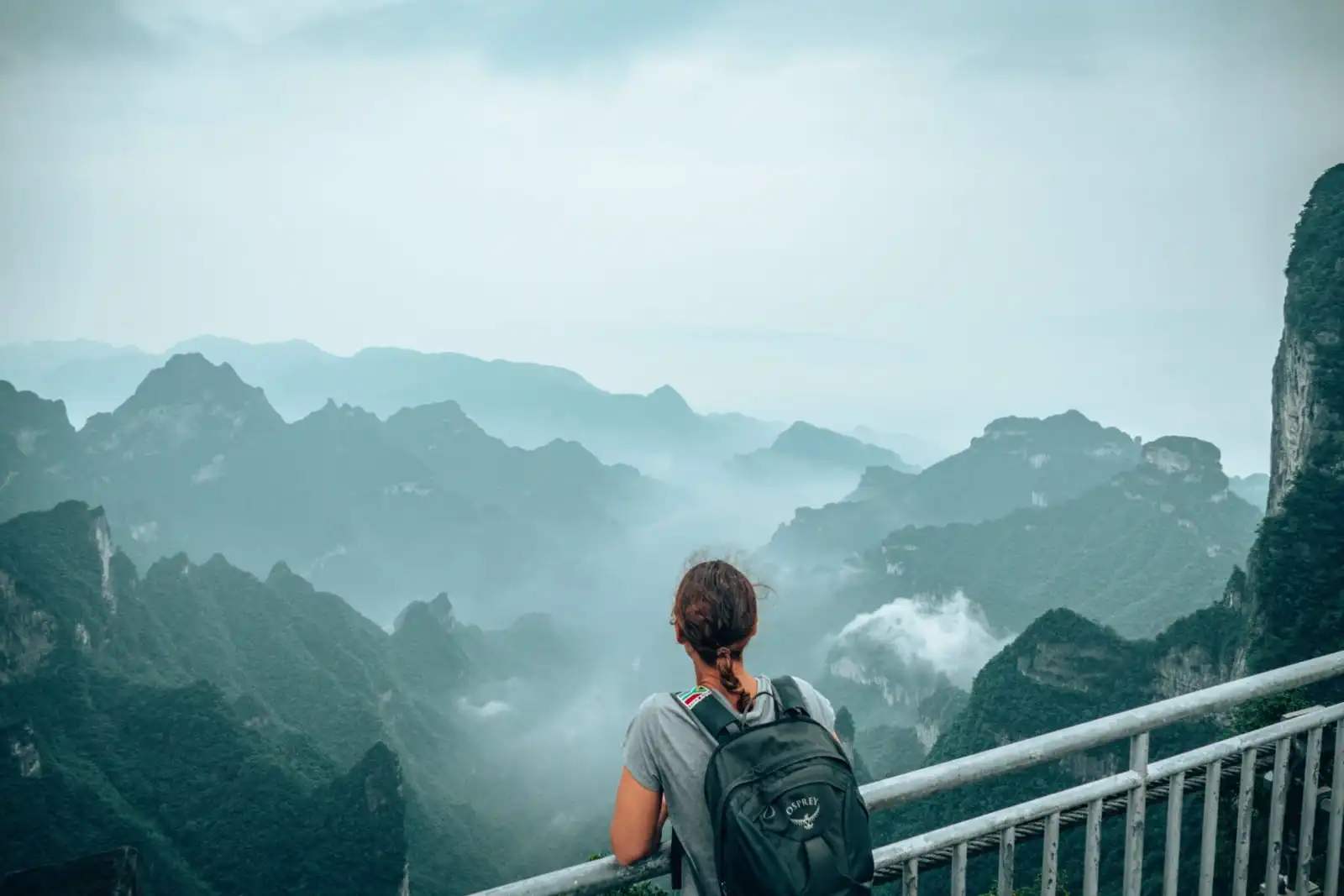
99 Turns Bus Ride
Once you’ve got hold of your tickets from the cable car station, if you are heading up on the buses first (don’t worry if not, the information is just in reverse and you’ll like do the mountain first before walking the Stairway to Heaven), head out to the rear of the building and you’ll see a load of buses waiting to ferry people up. This is actually the first bus ride of two you take to get up Tianmen. But don’t worry – it’s really easy. The first bus take around 10 – 15 minutes to the start of the National Forest Park, from here you then walk up the steps and check in with your tickets, joining another queue (not very long) to take you on another bus up which drives you to the summit.
We’re a little confused as to why you need to transfer buses but that’s the process!
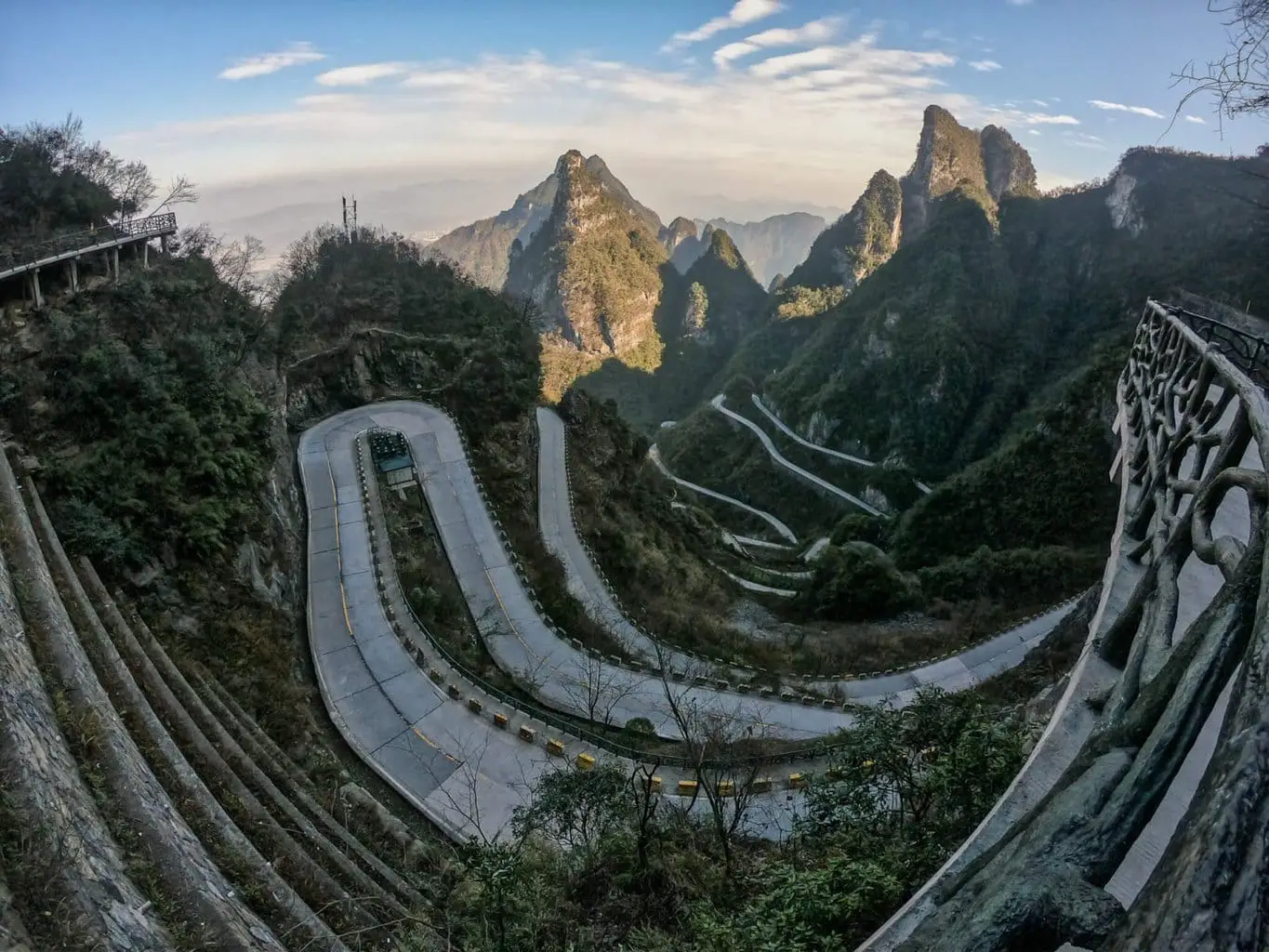
Photo credit: Eamon Hayes
The journey up Tianmen Mountain is a pretty wild ride. If you get motion sick, it’s worth having a tablet beforehand as you’re in for 99 hairpin turns to make it to the top. Apart from slightly hair-raising, it offers absolutely stunning views of the surrounding area.
Stairway to Heaven
After arriving at the bus station, you immediately see why this place is so important. Directly translated as ‘Gateway to Heaven’, in front of you lies a super impressive stairway, leading up to Tianmen Cave.
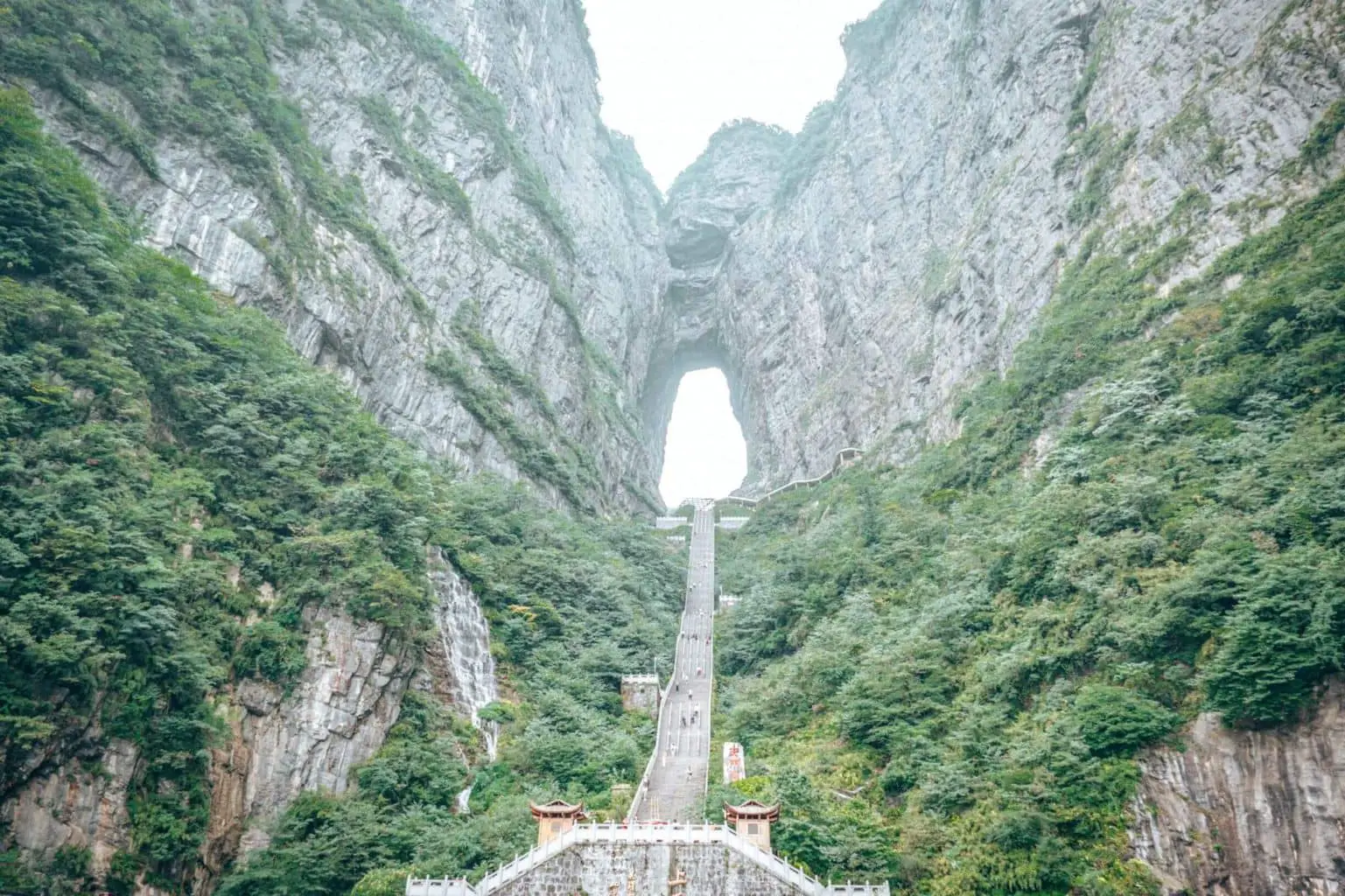
In total there are 999 steps, and although it’s daunting, you actually do the climb in next to no time! There are also plenty of areas that you can stop and have a seat on the way up! If you aren’t keen on attempting the climb, you can also take the escalator up instead that sits hidden to the right of the stairs.
At the summit of the Stairway to Heaven, you’re actually still quite a way from the top of Tianmen Mountain, but luckily there are escalators (7 of them from memory) that will take you all the way.
Walking the Mountain
Now at the top of the elevators, you now have a choice to either head out right or left, (to the East or West walkways) if, like us, you want to walk around the whole of the mountain. It is really worth doing this, as although it’ll take around 4 hours, the walk is not so strenuous.
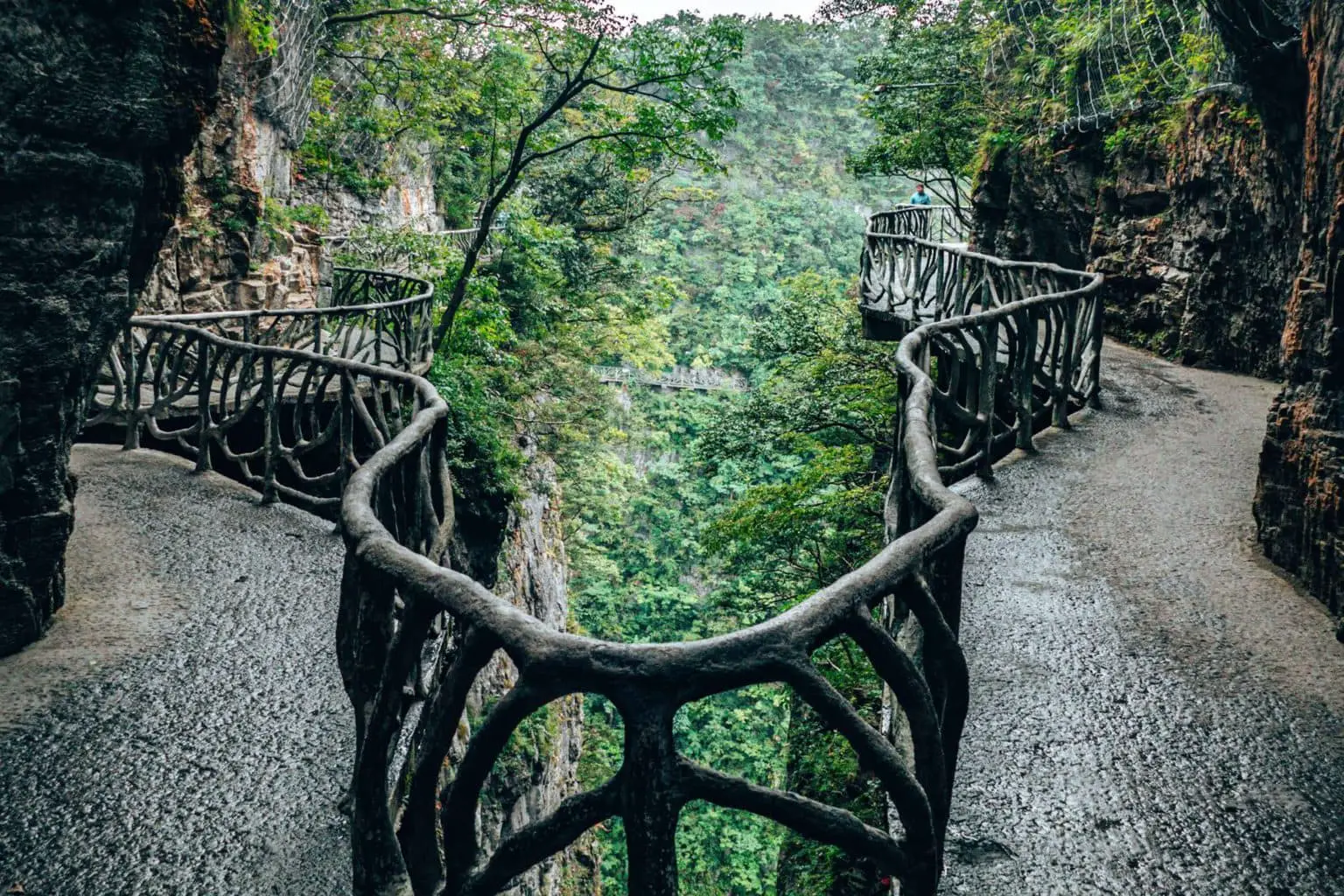
If you head out to the East walkways first, they seemed to be less crowded than the West side, this may of course been due to our timings. Along the walk, you’ll encounter some seriously impressive walkways that jut out from the side of the mountain, and there are a couple of glass walkways that are really worth doing (even if you’re not great with heights). The first you’ll come to is the East Glass walkway, and although not as impressive as the West one, still very much worth doing. You pay an extra 5 RMB (0.70 USD / 0.55 GBP) but in reality this is the cost for the shoe covers to keep the glass clean.
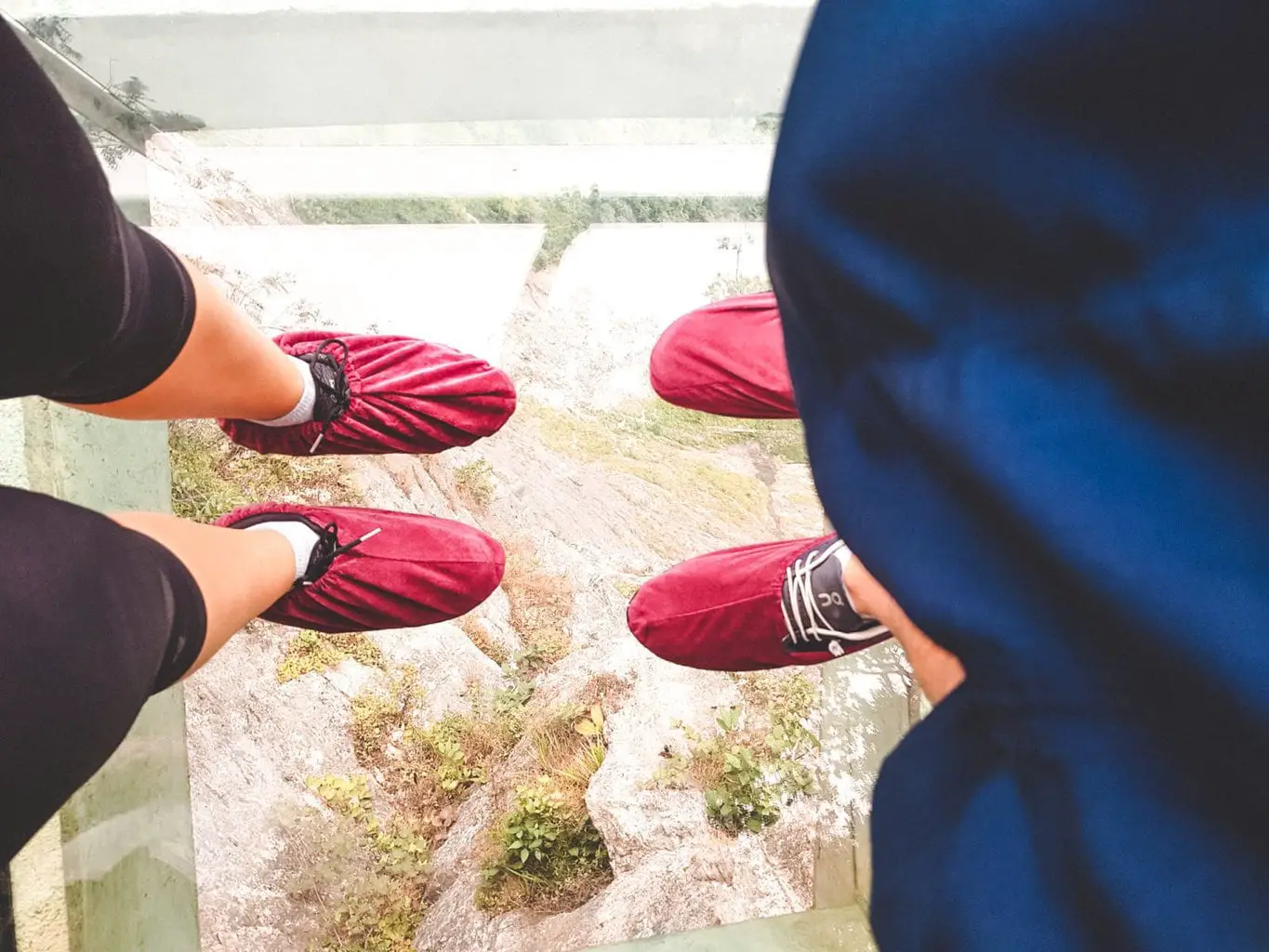
If you are taking the Cable Car up, it would make more sense to head to the West walkways first, so you’re not doubling back on yourself.
Cable Car
After you arrive back near the start of your mountain top walk, you’ll reach the cable car – which is a great experience by itself. Once the longest cable car in the world, you have a 30 minute relaxing return journey all the way back to the original cable car station in Zhangjiajie.
If you have more energy than us, you could also squeeze another activity into day 3 of the itinerary! If so, check out our recommendations below of bonus activities to add. Although, to be honest, we were exhausted by the end of this!
We obviously did loads of hiking (up to 20km each day and much of that up and down), however, you definitely can use more buses and cable cars than we did which will be a little easier on the legs. If you are planning on doing loads of hiking, it’s definitely worth getting a leg massage in Wulingyuan – it really eases the aches and loosens the muscles for the next day’s adventure!
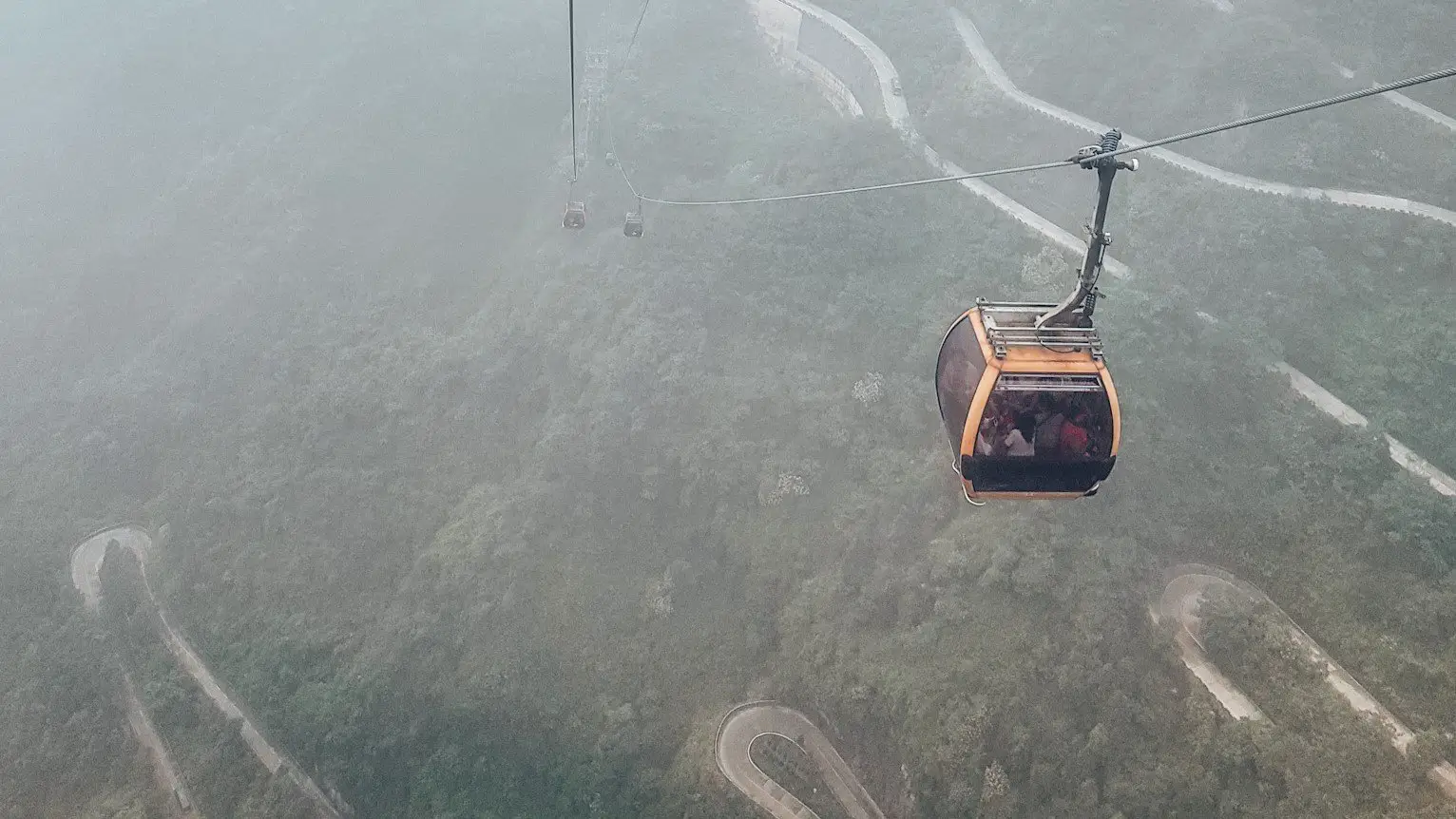
Read next: Here is our perfect 2 weeks in China itinerary and travel guide!
When is the best time of year to visit Zhangjiajie?
Zhangjiajie weather follows much of the northern hemisphere, in that it has the classic four seasons of spring, summer, autumn and winter. Winters can get down to freezing, but would offer stunning views, and is the quietest time of year. Summer can get pretty hot (over 30 degrees). And between May and August are the wettest months! But in a place that experiences over 200 days of rain or misty clouds, make sure that you take waterproof clothing regardless of when you go.
The best time of year – think less humid, warm but not hot and less chance of rain – are April and October. We were there in September and had wonderful weather, although quite humid on two days with the final day quite misty. The Chinese holiday months of July and August are also the busiest, so likely that accommodation costs will be higher, and the parks fuller.
Top tip: Don’t forget that the temperatures can be quite a bit colder on the mountain tops, so be prepared!
Bonus Activities to add to your Zhangjiajie itinerary
Yellow Dragon Cave
Just a short bus ride from Wulingyuan (20 minutes) is this enormous karst cave network, covering 100, 000 square metres. The Yellow Dragon Cave (or ‘Huanglongdong’ in Chinese) is a massive cave complex featuring a reservoir, underground waterfalls, pools and two underground rivers. Yes, China really does it bigger and better!
Some of the world’s largest stalactites and stalagmites form inside the cave, and it’s a really interesting journey to see them, and all the attractions which are illuminated in bright colours. That said, it can feel a little touristy – the many hued lights and many other visitors mean this is quite a commercial experience.
As to the journey itself, you’ll do parts of it by foot and the others through a 800m long boat cruise on the Xiangshui River. All of it is guided, and takes about 90 minutes.
At time of writing, it cost 100 RMB (14.30 USD / 11 GBP) for the ticket, and only 1 RMB for the bus which is Bus No 1 from Wulingyuan Bus Station.
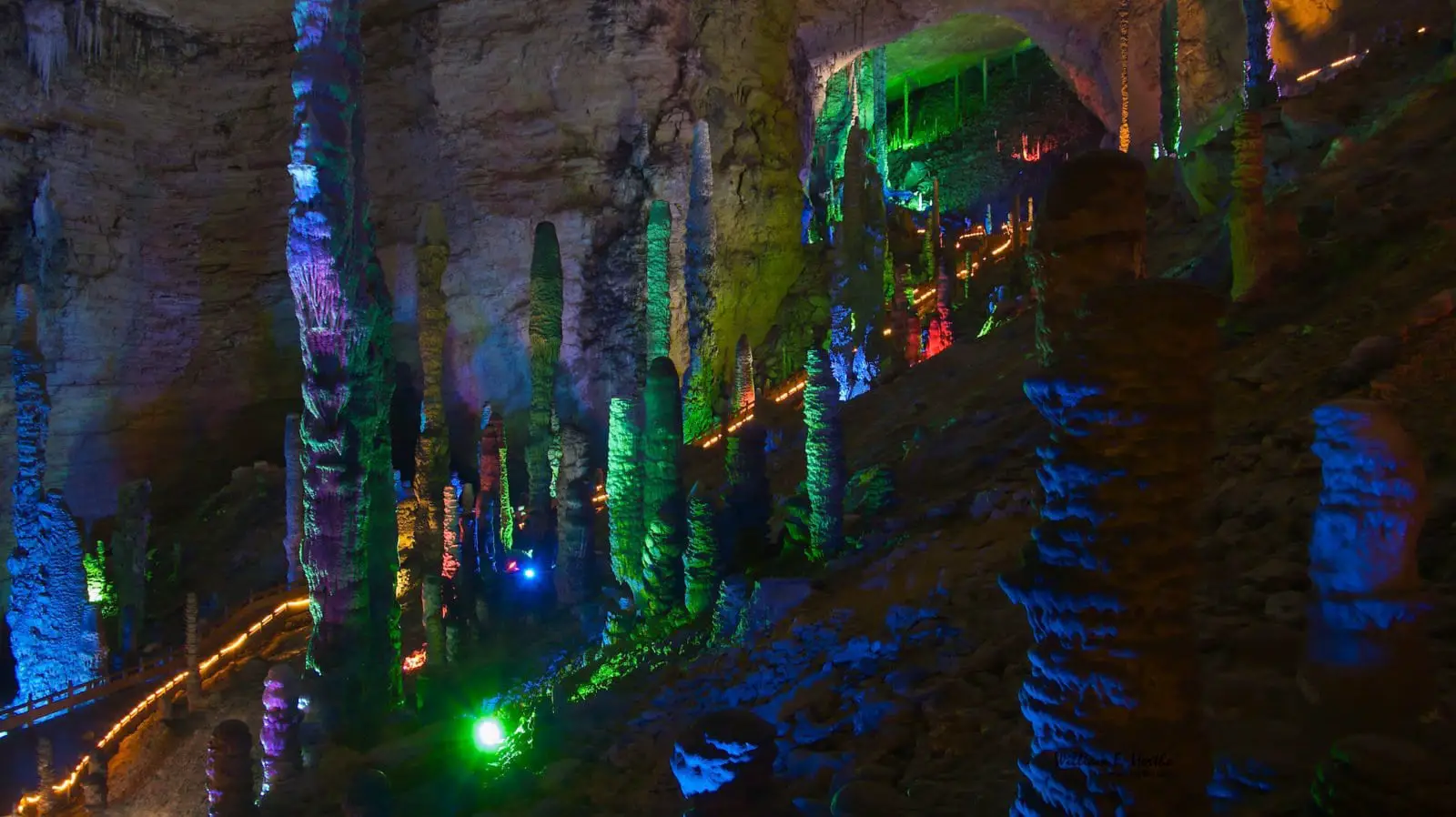
Photo Courtesy of Bill Hertha / Flickr
Baofeng Lake
As most of your time in Zhangjiajie and the Wulingyuan Scenic Area is about mountains and glass walkways, its worth doing something more water-based, like Baofeng Lake. This lake is 72 metres deep and about 2.5 km long, flanked by beautiful steep peaks. The water is incredibly clear and reflects the surrounding area, making this a beautiful, peaceful place to visit.
While you’re there, you can also do a scenic boat ride where you’ll take in the mountains to the tune of local singers performing Tuljia songs. You can also get off the boat and explore the fountains and a waterfall, via a short hike.
It costs about 96 CNY (14.70 USD / 11 GBP) and you get there via Bus No 1 from the Wulingyuan Bus Station.
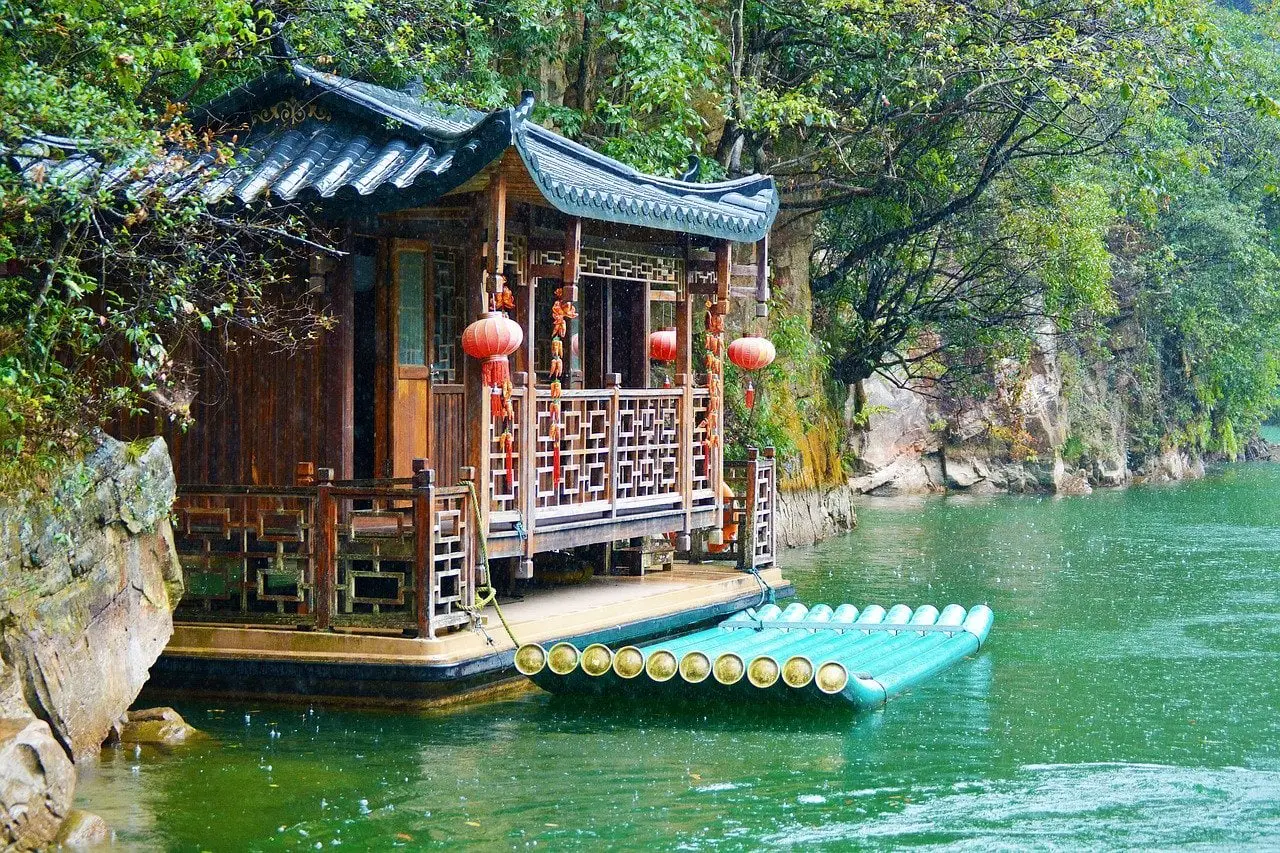
Grand Canyon and Glass Bridge
Last but definitely not least is the Grand Canyon and the Glass Bridge. These are technically two separate ‘attractions’ in that you can pay for them separately, or a combo ticket – more on that below.
The absolutely beautiful canyon is perfect for walking and hiking – you take wooden trails over a 3-4 hour hike, starting with the mind-blowing Strip of Sky, a long gap between two mountain cliffs where only one person fits at a time. You’ll walk a 700 meter long trail down to the bottom, before traversing through the canyon where you can also try your hand at the Sky Ladder Plank Road and the Southern Red Flag Canal, a beautiful canal that powers the nearby villages.
But it is the glass bridge that really attracts most visitors. The bridge (which shouldn’t be confused with the glass walkways on Tianmen mountain), is the world’s longest and highest glass bridge. Called ‘Yuntiandu’ it means ‘a way of clouds to the sky’ since it seems almost suspended in the air. The entire thing is transparent glass, giving you a heart racing view down to the bottom of the canyon.
It costs 118 RMB (16.80 USD / 13 GBP) for just the Grand Canyon, CNY 138 (20 USD / 15 GBP) for just the Glass Bridge and CNY 219 (31.30 USD / 24 GBP) for the combo ticket, at time of writing. From Wulingyuan bus station you take the bus to Zhangjiajie Grand Canyon which takes 20 minutes.
Zhangjiajie Travel Tips – What to pack for your Zhangjiajie Itinerary
You’ll definitely want to make sure you’ve got a decent day bag to take with you. We love our Osprey day bag and find it perfect for everything we need to carry on a day trip. But what are the essentials to include?
- Water bottle. Throughout China, the tap water isn’t drinkable. Do yourself a favour and get a LifeStraw – it’ll save you money in the long run and it’s good for the planet.
- Camera. The most important thing in our opinion. The landscapes are truly out of this world.
- Waterproof jacket or poncho. It can be cloudy and rainy up on the mountain, more likely than not. So make sure that you’ve got something that keeps you dry.
- Sunscreen and sunglasses. On the other hand, it can be surprisingly hot up there. We were really lucky that we had two sunny hot days.
- Snacks. You’ll want to take some good snacks for the walks, there are limited options on the mountains away from the main cable car stations.
- Great hiking shoes! If you’re like us and you want to explore, make sure you’re wearing a comfy pair of shoes, we walked on average of 20km each day, and a lot of that is steps. You can of course do less of the hiking, but it’s the best way to get away from the crowds. We love our Salomon XA Pro 3D.
- Tissues or toilet paper. You never know if there’s going to be any toilet paper on that bathroom break!
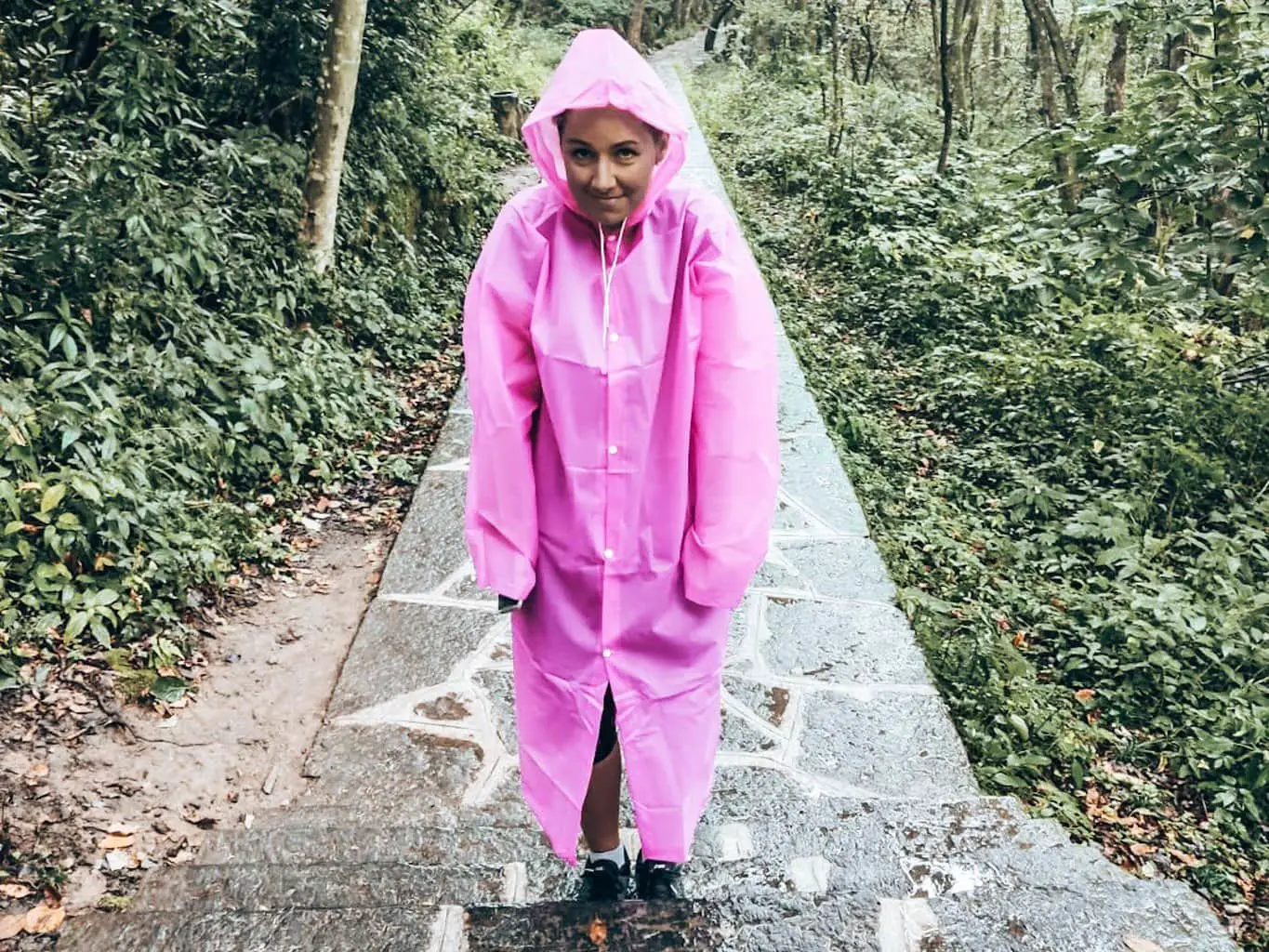
What apps should I use in Zhangjiajie?
We’ve actually created a super handy guide to all the apps that you need for travelling in China – check that out here. That said, here are some of the crucial ones:
VPN
Most importantly, make sure that you get a good VPN – it’s the most important app to have on your phone, otherwise you won’t be able to use most of the day to day programs that you are used to using. Think no Google, no Facebook, no WhatsApp, no Instagram etc… you get the picture.
We’d strongly recommend that you pick ExpressVPN. We used both that and its biggest competitor NordVPN, and found that on speeds and access, ExpressVPN just comes out slightly ahead – but both are great products!
And download the VPN and other apps before you go. Play Store won’t be available in China (without a VPN).
The other key apps that we’d recommend that you download:
- Taxi service. Uber (and our Southeast Asia favourite, Grab), don’t work in China. However, China does have their own equivalent which is pretty much the same – DIDI Chuxing.
- Maps. So for hiking routes, we love Maps.Me, as a lot of the routes are on here, when they don’t appear on Google Maps. You can also download regional and very detailed offline maps which means that even if you have no internet, you are always able to find your way around. It works on GPS positioning, which doesn’t require 3G connectivity. Quite useful in the mountains of Zhangjiajie!
- Translation. The most tricky thing about travelling in China is definitely the language barrier. Unlike the rest of South East Asia, English is pretty much not spoken outside the major cities. So it’s worth having Google Translate in your pocket. They also have a handy offline version for Chinese so you don’t need the internet to work it either.
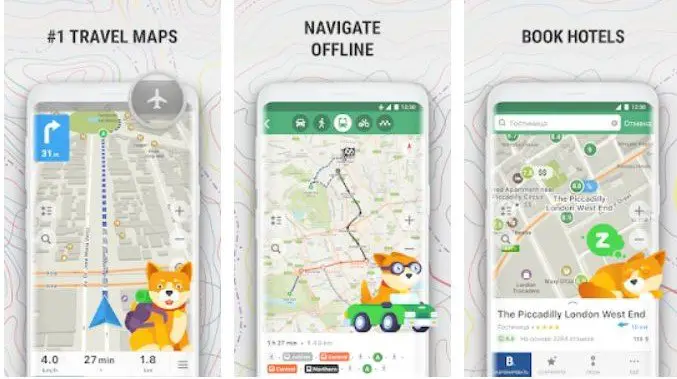
What camera equipment and other gear do we use?
We’re living proof that you don’t need the most expensive gear to travel the world and take good photos. Here are some of our must have items that make it into the packing list for all our travels.
- Main Camera: Panasonic Lumix FZ1000
- Drone: DJI Mavic Air – Fly More Combo
- GoPro: Hero 7 Black
- GoPro Dive Case: Go Pro Housing
- GoPro Case: Smatree GoPro Carry Case – Small
- Packing Cubes: Eagle Creek Packing case
- Backpack: Osprey Farpoint 70
- Powerbank: Anker Powercore
- Phone: Xiaomi Mi 9
- Hard drive: Transcend Slim Storejet 2TB
- Laptop: Lenovo IdeaPad 720s
- Headphones: Bose Quiet Comfort 35
- Wifi Hotspot: GlocalMe G4
Want to save this for later? Why not pin it…
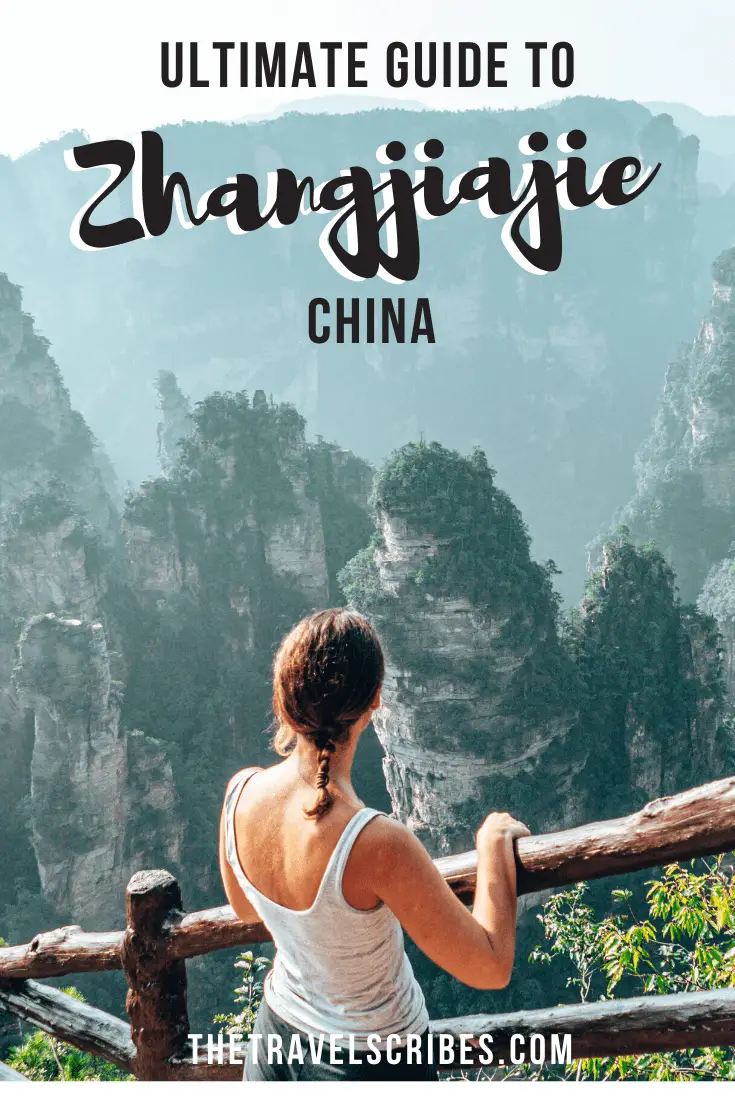

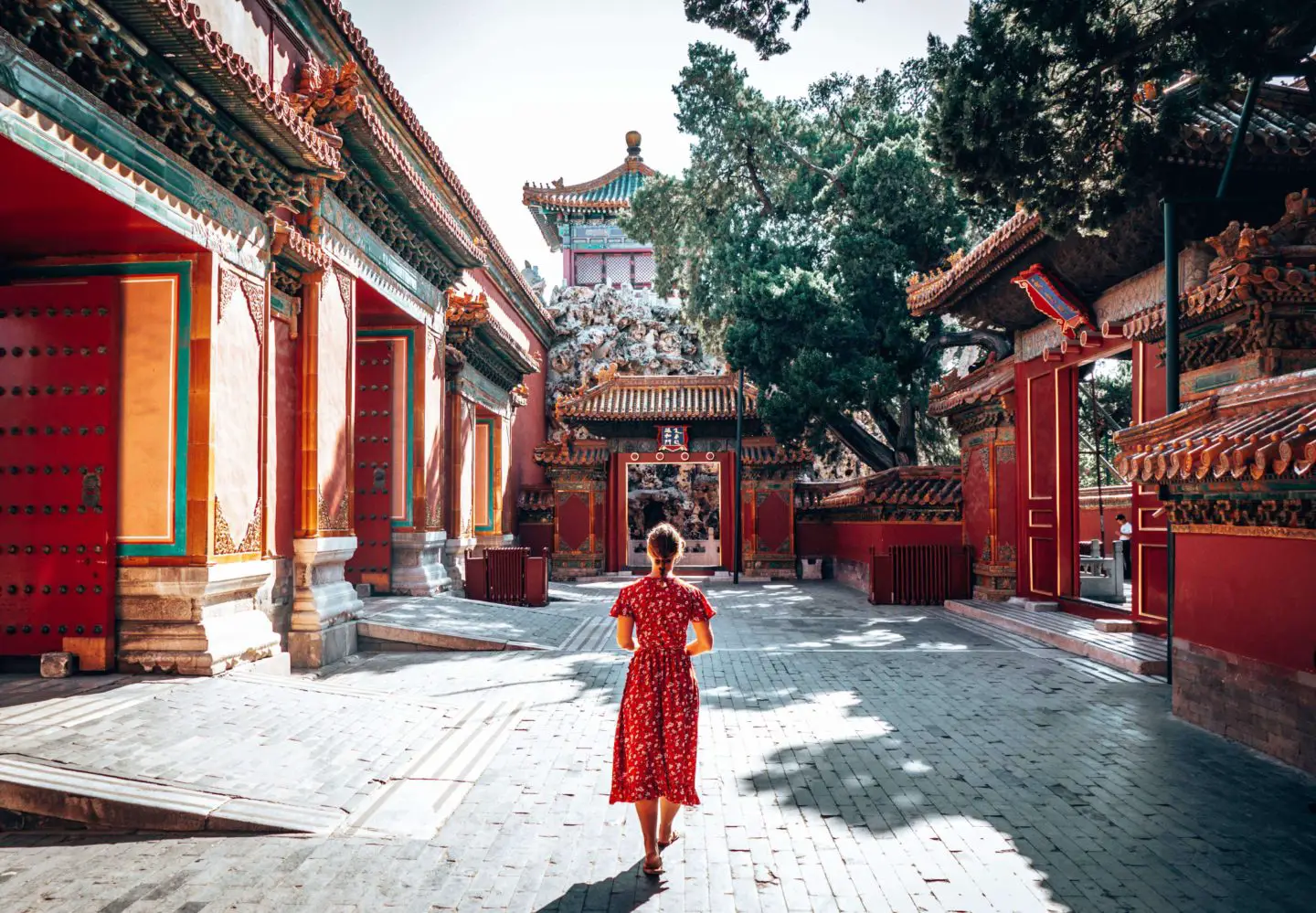
Thank you for suggestions, but honestly interesting that express came up a better, I’ve used them in the past and I had some trouble, of course, their support helped me out from time to time, but even then its a bit more expensive. Switched out to NordVPN eventually when they released the Christmas deal. Anyways, I’m going to travel through there, and I’m really excited about it.
Absolute pleasure! And definitely do let us know if you need any other advice! Enjoy it and we’d love to hear back from you, if you have any recommendations to add after you’ve visited Zhangjiajie.
In terms of the VPN, it’s a real toss up between the two services. I was actually all for NordVPN before China, but it just pipped it on performance there (most of the time).